A visit to Fuji Q Highland was one of the most anticipated experiences ahead of our most recent trip to Japan particularly for myself and my two thrillseeking older children. We had first become aware of Fuji Q when planning our previous Japan holiday but at the time we weren’t able to fit it into our itinerary. This time however we planned to spend three days in the Mount Fuji area so Fuji Q immediately became part of our trip plan.
Fuji Q doesn’t have the highly polished theme park design of Disneyland or Disneysea. Fuji Q Highland’s claim to fame is that it hosts some of the most extreme rides in the world with four Guinness World record-breaking roller coasters. It is pure roller coaster heaven for adrenaline junkies.
Check out our detailed guide below to learn more about Fuji Q Highland including a detailed overview of each ride and other attractions, as well as how to book your tickets.
Disclaimer: This article contains affiliate links. That means that if you make a booking after clicking on a link it may mean that we receive a small commission at no extra cost to you. Thank you!
Fuji-Q Highland Amusement Park: One-Day Pass Ticket
- One-Day pass for both Fuji-Q and Thomas Land
- Select from Adult, Youth, Child, Infant and Senior ticket options
- Excludes Super Scary Labyrinth of Fear ticket
Fuji-Q Highland: Afternoon Pass Ticket
- Enjoy unlimited thrilling rides from 1:00 PM to closing
- Select from Adult, Youth, Child, Infant and Senior ticket options
- Excludes Super Scary Labyrinth of Fear ticket
Fuji Q One Day Pass with Return Bus Transfer from Tokyo
- One-Day pass for both Fuji-Q and Thomas Land
- Select from Adult, Youth and Child ticket options
- Return Direct Bus Transfers from Tokyo (Shinjuku Station) - enables you to have 9 hours to enjoy Fuji Q!
- Excludes Super Scary Labyrinth of Fear ticket
Fuji Q Highland Tickets
The Fuji Q ticket options are to purchase either a Day Pass or Afternoon Pass. All rides are included in both passes with the exception of the Super Scary Labyrinth of Fear.
Fuji Q is open from 9am each day, and closes at either 5pm, 6pm, 7pm or 8pm. Some days the park is closed. You can find out the planned opening hours for the day you plan to visit at this link (use Google Translate to see the page in English).
A great option to purchase your Fuji Q Highland Day Pass or Afternoon Pass (which can be used from 1pm to closing) is through Get Your Guide.
Click here to check out and book your Fuji Q Day Pass or Afternoon Pass through Get Your Guide
Klook has a great Fuji Q package which includes your Fuji Q entry pass plus return direct bus trip from Shinjuku Station in Tokyo. You get 9 hours to make the most of Fuji Q and can sleep on the bus on the way back to Tokyo!

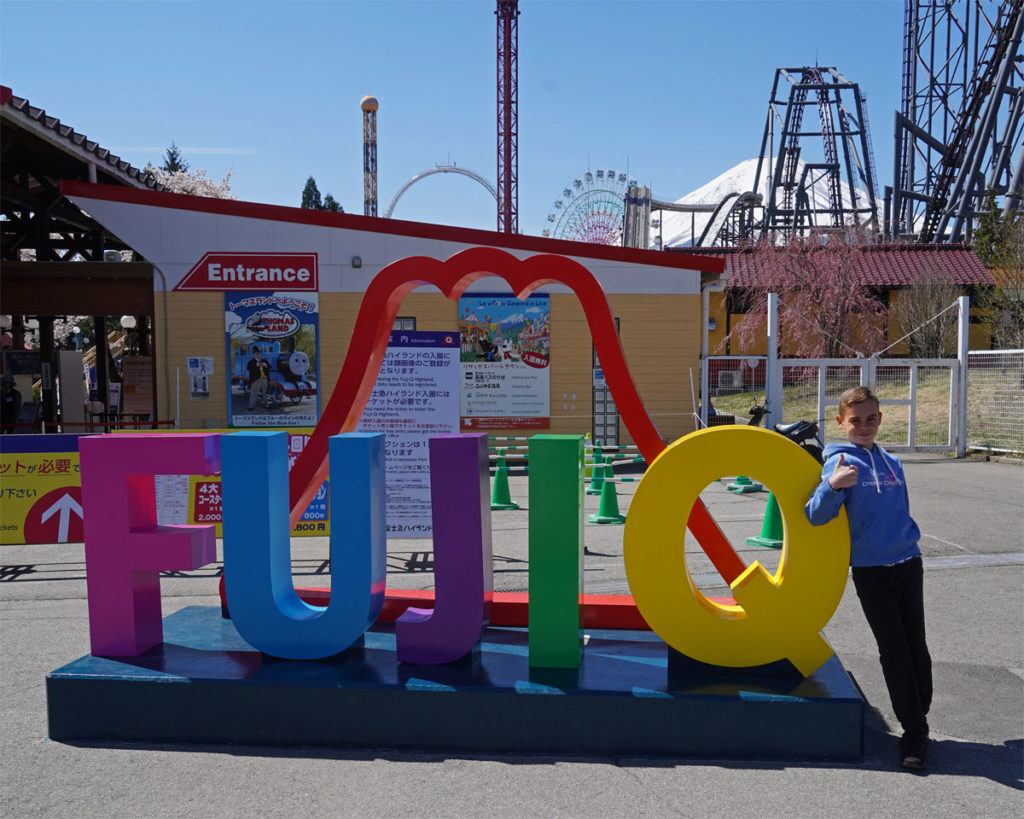
Our Fuji Q Experience
The other feature that sets Fuji Q apart from all other theme parks is that it has the most spectacular setting of any theme park we have ever visited. On a clear day like we enjoyed you can see Mt Fuji from almost anywhere in the park. It is a truly breathtaking experience to be able to sit on an extreme rollercoaster with the beauty of Mt Fuji right in front of you. It’s clear that the rides have been designed in such a way as to maximise the views of Fuji-san. For example, as you reach the peak of Takabisha and are about to descend into an insane 121-degree drop, the ride pauses to both build anticipation and admire the grand mountain.
One of my daughter’s best friends had previously visited Fuji Q and said that after riding the roller coasters at Fuji Q all other theme park rides seemed extremely tame. The day of our Fuji Q visit, we woke up full of excitement but just before we were about to drive to Fuji Q my daughter started vomiting having picked up the bug that had passed through the rest of our family over the last three days. My daughter was deeply disappointed which left just myself and my oldest son to visit the theme park.
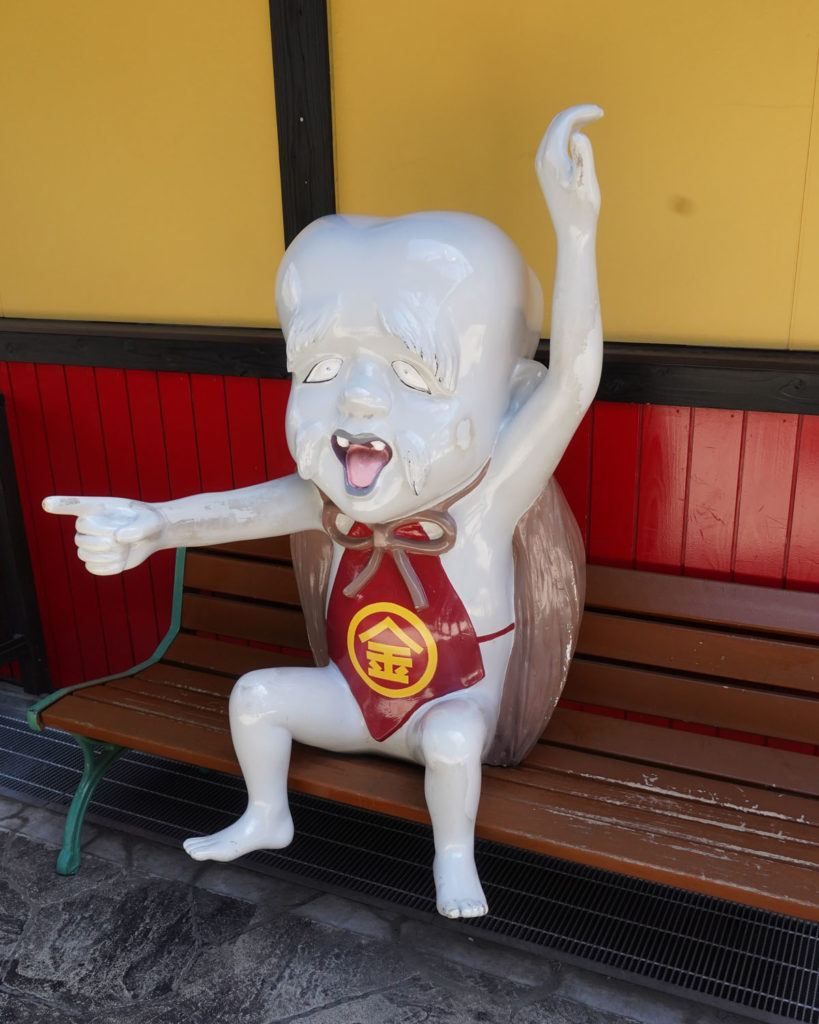
While it was very unfortunate that our daughter couldn’t join us, our visit to Fuji Q was otherwise blessed by the perfect combination of a small crowd and fantastic weather with clear blue skies. When planning your trip to Fuji Q, I would recommend keeping an eye on the weather on the days before you are planning to visit. While some indoor and splash rides will continue to operate, rain will take most of the coasters out of action and high wind conditions can also cause rides to close. If the weather forecast is not looking good for the day you are planning to visit Fuji Q and you have some flexibility in your schedule, see if you can change days.
Fuji Q Fast Pass
Fuji Q has the unfortunate nickname of Fuji-Queue because of the horrific wait times on busier days. These horrific queues can be attributed to the fact that you have four massively popular rides in a medium-sized park. This is compounded further as most of the rollercoasters at Fuji Q only have one vehicle in action, unlike theme parks such as Disneysea and Disneyland where one car is being loaded with people, while another vehicle is on the track. This means that the major coasters can only handle a relatively small number of people per hour and lines can feel like they are moving at a snail’s pace.
In addition to day passes, if you want to make the most of your day, buy as many Screaming Priority Passes as you feel comfortable paying for. Even with priority passes, there will still be a small amount of queuing for each ride. Buying priority passes is a little like taking out insurance. There is a small chance you may not end up needing them, but if you are faced with massive queues for the most popular rides you’ll be glad that you have them. While fast passes add to the cost of visiting Fuji Q, they will allow you to have a far more enjoyable day. You will need to have a day pass in order to use the priority tickets.
Screaming Priority Passes become available only 3 days prior, and you need to sign up to become a Fuji Q member to access them. You can only purchase up to 10 skip the queue passes via the Fuji Q app. I tried to sign up to become a Fuji Q member, however it requires you to have a Japanese phone number. If you purchase a Japan sim card with voice it could be worthwhile to try to register after your account has been activated.
It’s much easier to purchase Screaming Priority tickets when you arrive at Fuji Q. The best way to buy all your fast passes is from the Screaming Priority Ticket Booth located near the merry-go-round (see page 2 on the attached map).
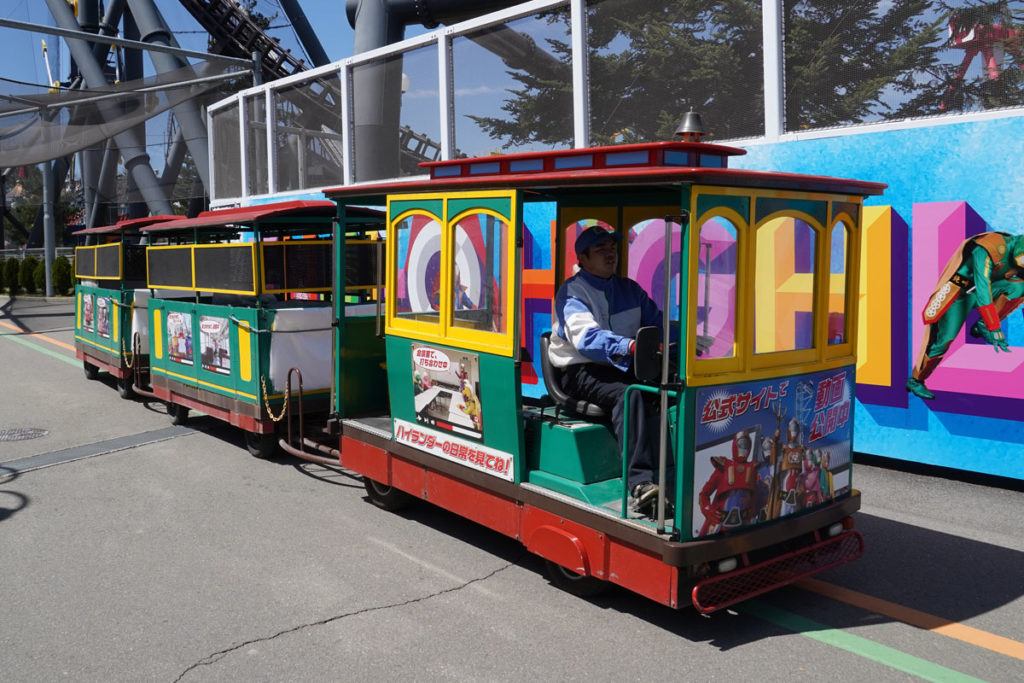
The only situations where it may not make sense to buy a fast pass is if the day you are visiting is forecast to be a quiet day, or you are happy to just go on a couple of rides and spend a long time in queues. Definitely check out the Fuji Q past congestion calendar and the congestion forecast calendar to help you work out what crowds may be like on the day you are planning to visit. Use Google Translate to see these pages in English.
We visited Fuji Q on the 16th April 2019 which was a very quiet day (congestion rating of 32) based on the Fuji Q congestion calendar (see the congestion calendar for April 2019 below). The Fuji Q congestion scale ranges from 20 to 100 with 50 representing the average of all days and 100 being the highest crowd in the year. Because we went on a very quiet day, we managed to smash out 13 rides and attractions in about 6 hours without ever feeling pressured or stressed. We were able to speed things up a little thanks to priority tickets for Takabisha, Fujiyama and Desperation Fortress 3 but would have managed just fine without these priority tickets.
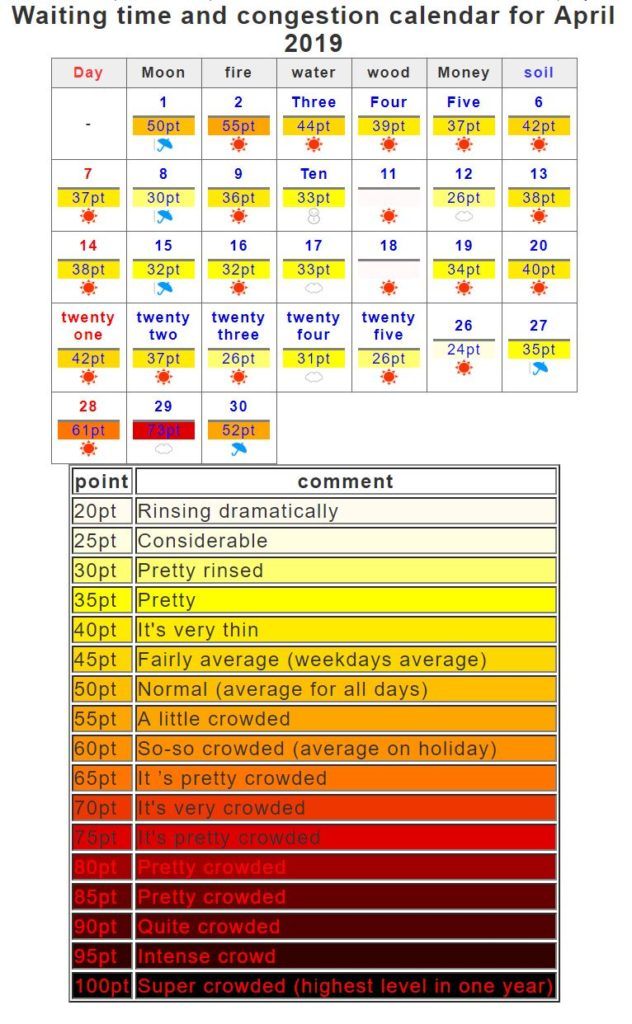
However, even on a reasonably average day (45 -55 rating), you can expect wait times of up to 2 hours on the most popular rides. As an example of this Eejanaika had a peak wait time of 120 minutes on 3 September 2019 (congestion rating 45). The maximum wait time for Takabisha on the same day was 120 minutes, while Fujiyama peaked at 70 minutes. I couldn’t access the wait times for Dodonpa but it has similar popularity to Eejanaika and Takabisha so you can expect similar wait times.
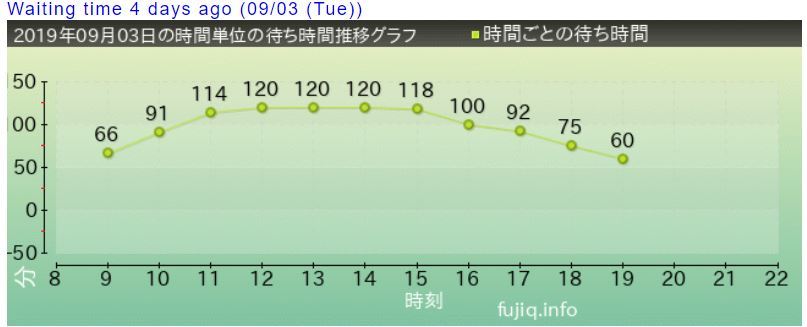
On a busy day, you can expect nightmare queues with wait times for the most popular rides soaring over 3 hours.
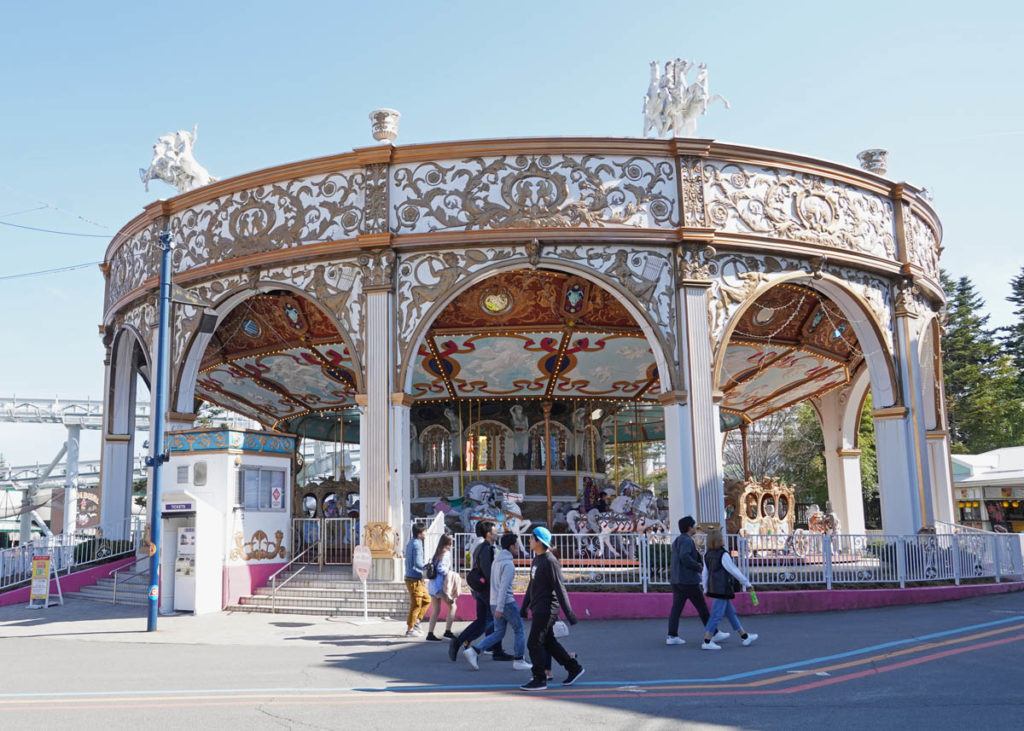
Priority tickets can also be bought from ticket vending machines located near the attractions. Each priority ticket costs 1300 yen (US $12) and you can buy up to 9 tickets per person each time. When buying tickets you have to choose both the ride and the time frame you want to go on (in one-hour blocks e.g 10:00 to 11:00). The maximum number of passes per one hour block is two so spread the priority tickets over the time you will be at Fuji Q. We have a detailed review of the major rides later in this article which can help you decide which rides to buy fast passes for, but my suggested rough order of priority would be Eejanaika, Takabisha, Dodonpa and then Fujiyama.
If you aren’t able to buy fast passes for all your preferred rides, buy priority tickets for your “must ride” coasters and then wait in line for whatever coaster has the lowest queue time. Some rides such as Eejanaika and Fujiyama do have single rider lines which can significantly reduce wait times, but they can shut down at random times in the day so you can’t rely on this option when buying fast passes.
There is only a limited number of priority tickets sold per day and they will sell out quickly, particularly on busier days. This means it’s important to try and get to Fuji Q as early as you can (preferably before opening). If you have the time, stay locally in Fujiyoshida on Lake Kawaguchi. Some hotels in Fujiyoshida such as Fujisan Station Hotel are designated as Official Fuji-Q hotels. Some of these official hotels offer extra perks such as priority admission to Fuji Q fifteen minutes before the official opening time. This extra 15 minutes will give you a head start to get Zekkyo priority tickets. If you aren’t able to stay locally and are visiting Fuji Q as a day trip from Tokyo, catch the earliest possible bus or train so you get to Fuji Q as close to opening time as possible.
Once you have organised your priority tickets you should have time to line up normally and ride at least one roller coaster before the first one hour block for the priority tickets starts from 10 am. Use the Fuji Q Wait Time app to check the wait time on your preferred ride/s before you try this.
Fuji Q Attractions
There are over 40 different rides and experiences to enjoy at Fuji with a great mix of thrill rides, family rides and children’s rides and experiences. Because I was with my thrill-seeking son we focused primarily on the thrill rides. There are also plenty of experiences such as Labyrinth of Fear, Ultimate Fortress 3, and Evangelion World for adults and older children to enjoy.
If my wife and younger son were with us we would have tried out a greater range of family-oriented rides. The range of more traditional rides include a teacup ride, log flumes, Ferris wheels, sky swings and carousels, pirate ships and drop rides.
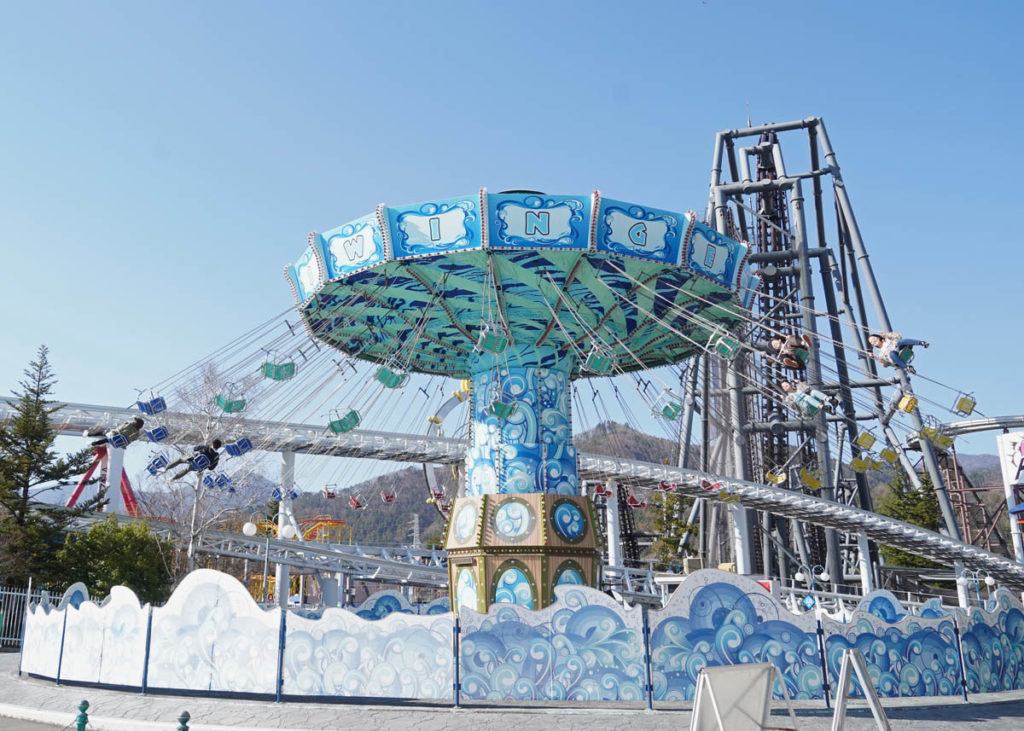
For younger children, there are a bunch of rides and experiences to enjoy in Thomas Land. There is also La Ville de Gaspard et Lisa for children, which resembles a French village decorated with themes from the Gaspard and Lisa picture book and animated TV series.
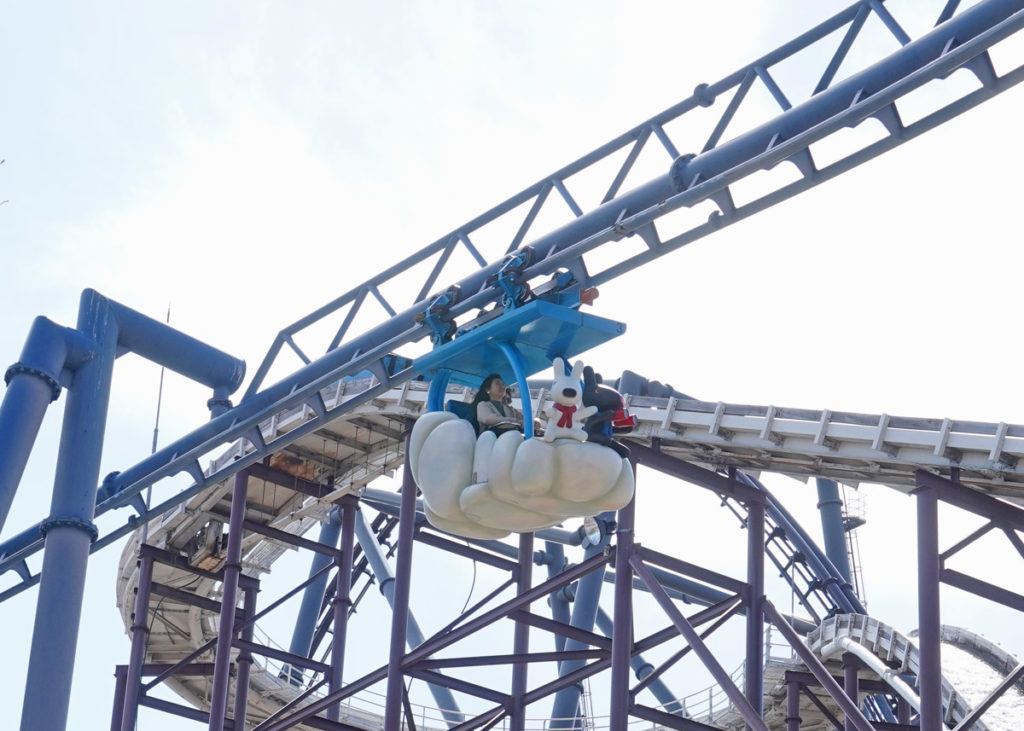
From late October to early April, an ice skating rink is also open with fantastic views of Mt Fuji.
Lockers
If you are bringing a lot of things with you, there are both large and small coin lockers available to store your items before going on the rides. Otherwise, individual rides also have storage lockers which you must use before going on a ride. The thrill rides will ask you to remove and store your hats, watches, phones, rings, etc before going on the rides.
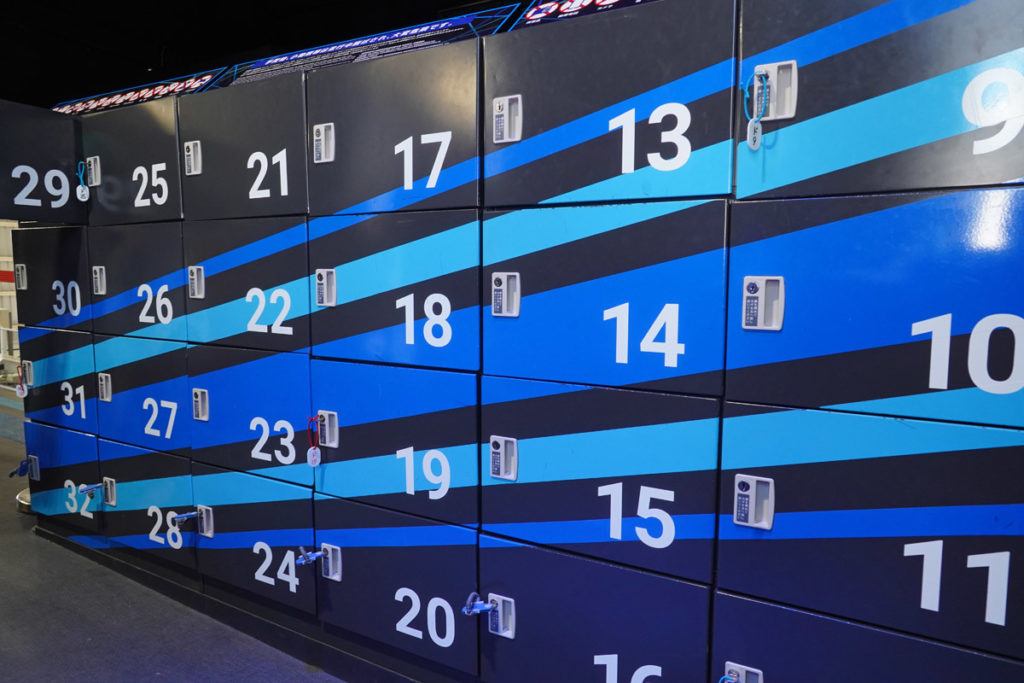
Facial Recognition System
Another consideration to be aware of is that Fuji Q uses a facial recognition system throughout the park. As you enter the park, an initial photo of your face is taken as part of the registration process. This image is then used as your ticket to gain access to all of the rides throughout the park, including for priority access to rides.
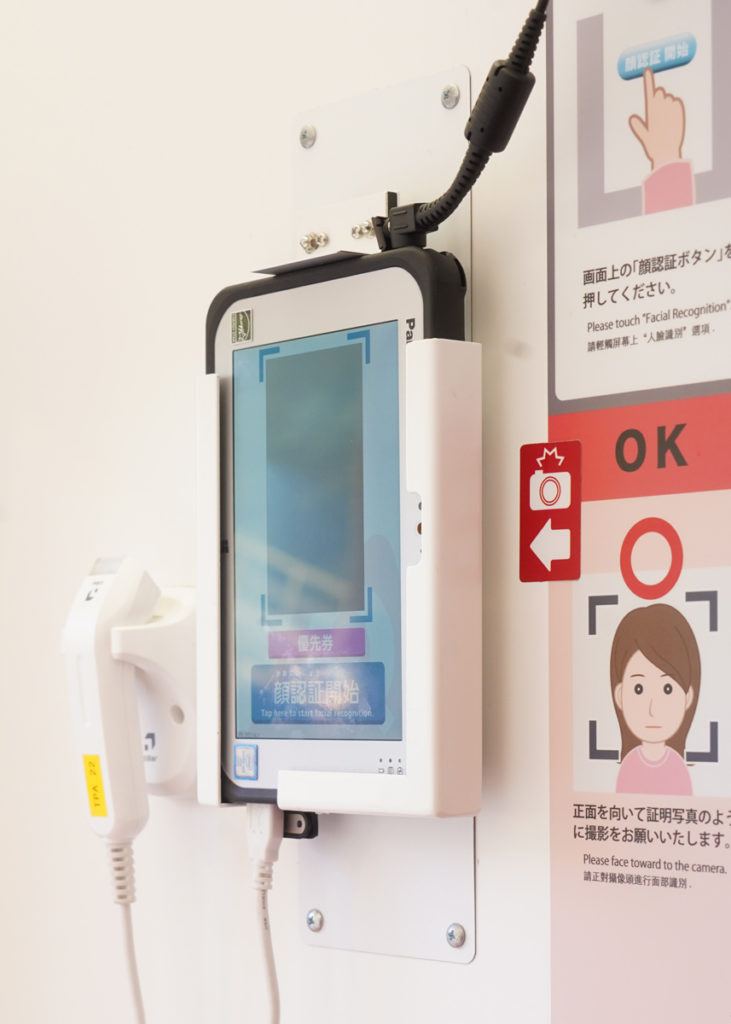
Fuji Q Highland Rides
Our plan for the day was to focus first on the four world record-setting roller coasters and then experience as much of the rest of the park as possible in the time we had left.
The Big Four
The “Big Four” rides at Fuji Q are without a doubt Eejanaika, Dodonpa, Takabisha, and Fujiyama.
- Eenajaika – Eejanaika opened in 2006 and it still holds a Guinness World Record for the most number of inversions with 14. I rate this ride as a 10/10 experience. It’s definitely the best roller coaster I have ever experienced.
- Takabisha – Takabisha opened in 2011 and it still holds the record for being the world’s steepest rollercoaster with a drop angle of 121 degrees. Takabisha is also a 9/10 ride in my mind and also holds a place in my top 5 roller coast rides.
- Dodonpa – When Dodonpa opened in 2001 it claimed two Guinness World Records for fastest roller coaster in the world (180 km/hr or 112 miles an hour) and fastest acceleration. Dodonpa still holds the record for fastest acceleration. It can accelerate from 0 to 172 km/hour (107 miles per hour) in 1.56 seconds. I give this ride an 8.5/10 rating. It sits just outside my top 5 roller coaster experiences purely because I wish the ride was longer.
- Fujiyama – Fujiyama is named after Mt Fuji which provides such a spectacular backdrop to Fuji Q. Fujiyama literally means “Fuji Mountain”. When Fujiyama was built it held Guinness World Records for both the world’s tallest rollercoaster (79 metres / 259 feet) and had the largest drop (70 metres / 230 feet). For a year it was also the fastest rollercoaster but this was never an official record. I rate Fujiyama as an 8/10 experience. It’s a lot of fun and the ride goes on forever but it doesn’t compare to Eejanaika, Dodonpa or Takabisha and would be just outside my top 10 roller coaster experiences.
Eejanaika Fuji Q
Eejanaika is without a doubt the wildest and most insane ride I have ever experienced.
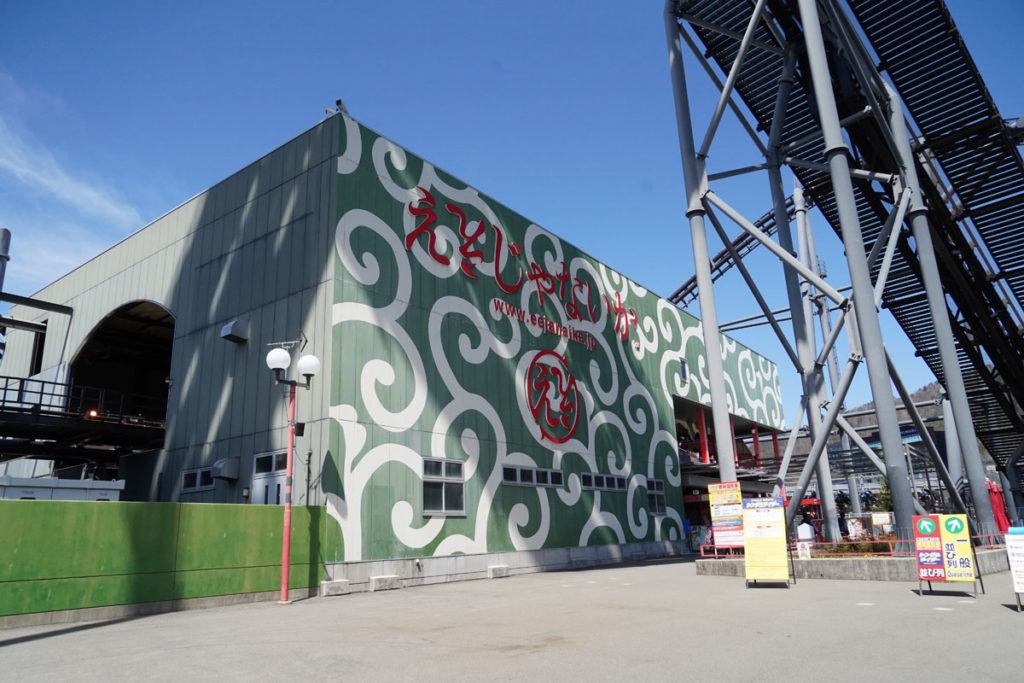
It’s described as a fourth dimension roller coaster. Unlike more traditional rollercoasters where the seats are in a fixed position, the seats on the Eejanaika can rotate 360 degrees both forwards and backwards. The rotating seats are what takes the experience to a whole different level. While the actual track features three inversions, the rotation of the seats means that you will actually be subjected to 14 inversions in a little over two minutes.
While waiting in the queue for the ride, a soundtrack chanted “Eejanaika” over and over and over. This chant bored into my head like an earworm, so much so that months after going on the ride I can still vividly recall the chant. When my son and I reached the front of the queue we strapped ourselves into some of the most well-padded and protected seats I have ever seen and were then thoroughly checked by the ride attendants.
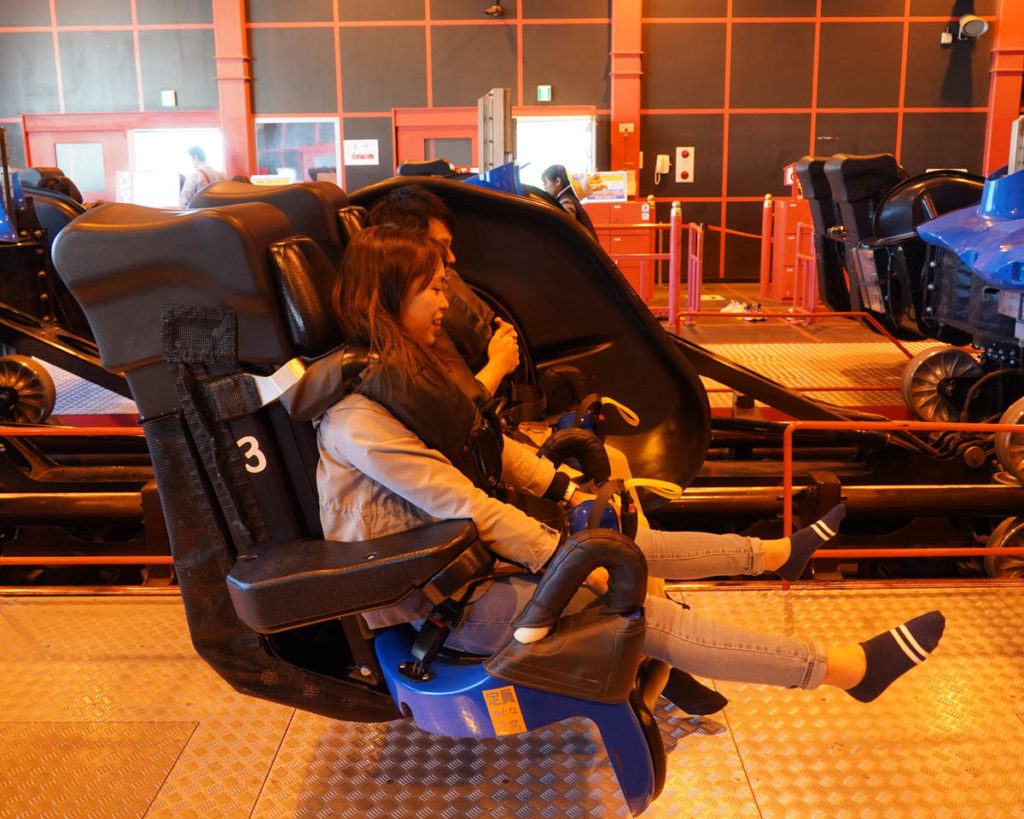
With our feet dangling in the air we were then launched backwards almost straight into a sharp drop which definitely lifted our heart rates before going straight into a 76 metre backwards climb. While the views over the surrounding area were fantastic, it was hard to really appreciate them as the backwards climb continued. My stomach started to feel like it had a flight of butterflies inside, due to uncertainty about how much further there was to climb and what would happen when we reached the top.
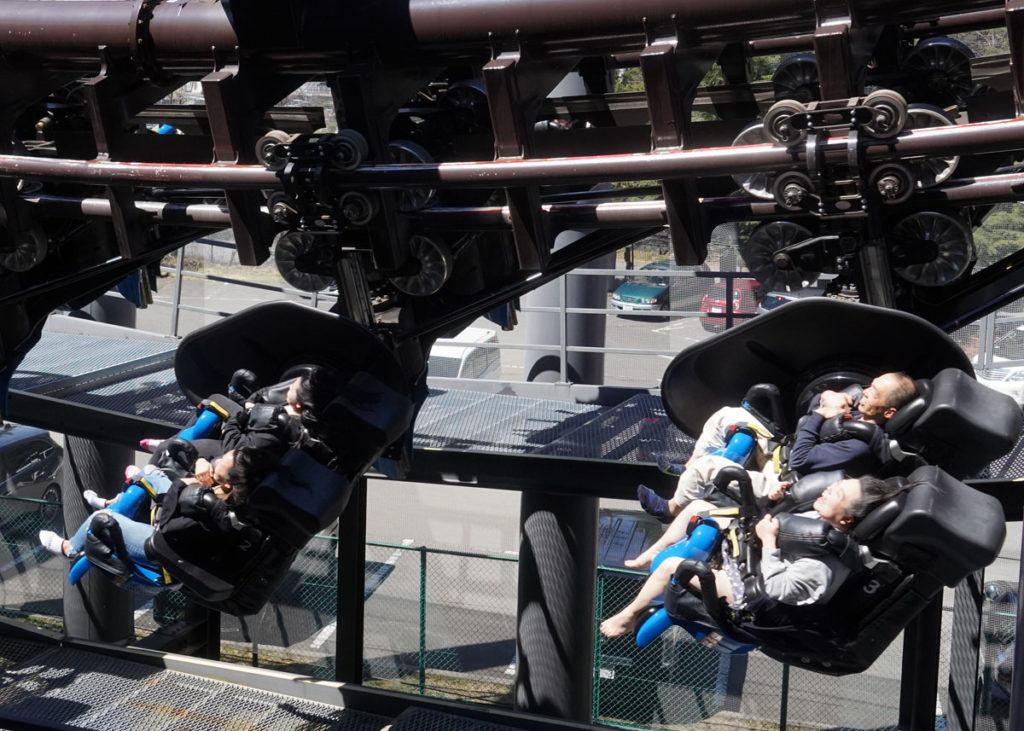
After passing over the top of the climb, we were suddenly facing downwards and the real fun began. The track was spinning, the seats were spinning and for the next minute, it was if my brain had shut down and I was living completely in the moment. I almost lost almost all sense of perspective and it felt like I was trapped inside a massive, violent tornado travelling at over 125km/hr as my body was thrown and spun in every possible direction.
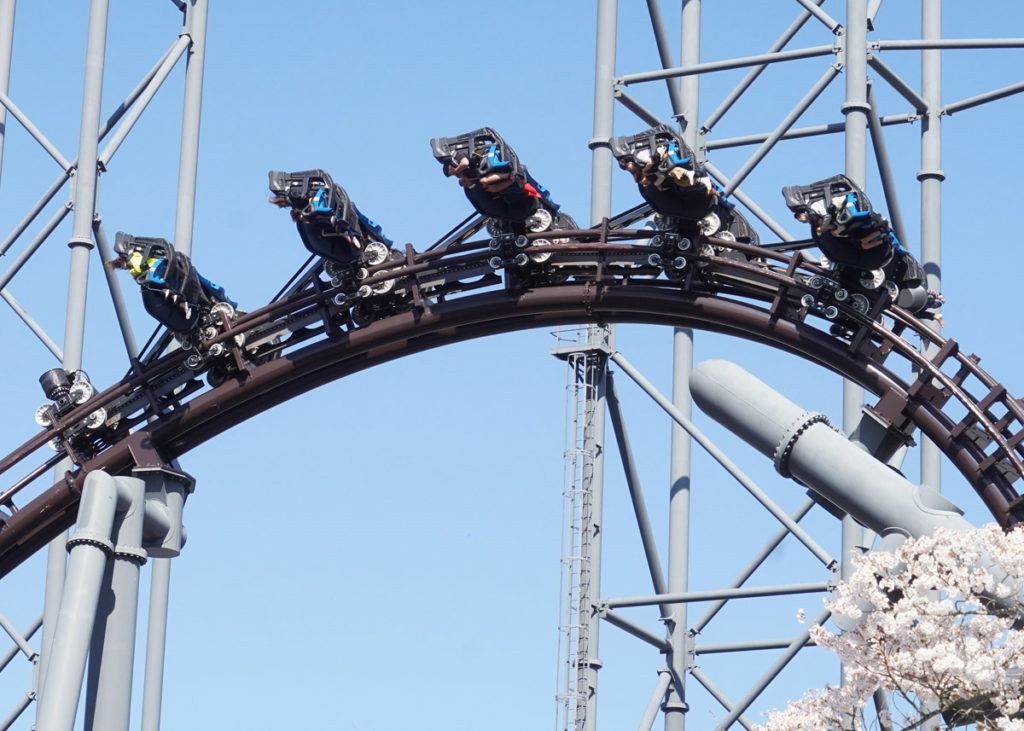
If it wasn’t for the fact that we wanted to sample as many rides as possible at Fuji Q, we would have happily gone on Eejanaika 2 or 3 more times just to relive that experience. If you love thrill rides, don’t miss going on Eejanaika. It’s an absolute beast of a coaster!
Takabisha Roller Coaster
I loved Takabisha not just for the world record beyond vertical drop but the sheer variety of thrills over a ride that seemed to go on forever. Of the Big 4 rides at Fuji Q, it is the second-longest ride behind Fujiyama.
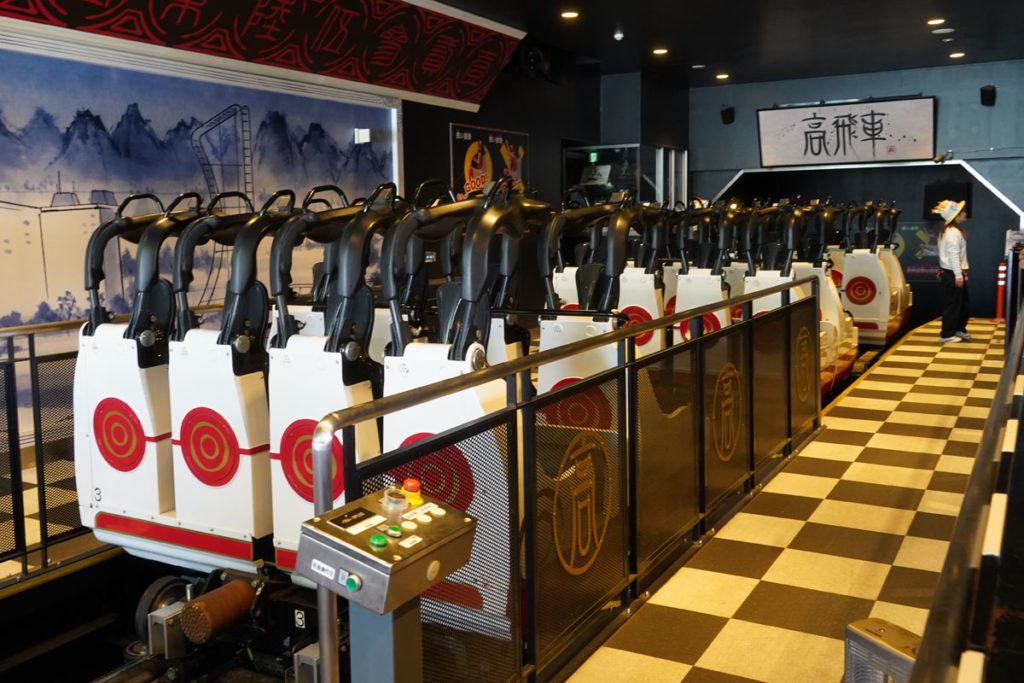
Takabisha started as a dark roller coaster. At the start of the ride, we dropped into darkness and then went straight into a barrel roll before accelerating up to 100 kilometres down a tunnel and then flying out of the building into the open air. Once in the open air, we went through a series of 3-4 inversions before returning to the building. Although the ride had already been a lot of fun, my son and I looked at each other with disappointment that the ride was already over. But the experience was actually only just getting started.
After entering the building, the ride took a 180 turn back out of the building and we immediately started climbing a 43-metre completely vertical hill.
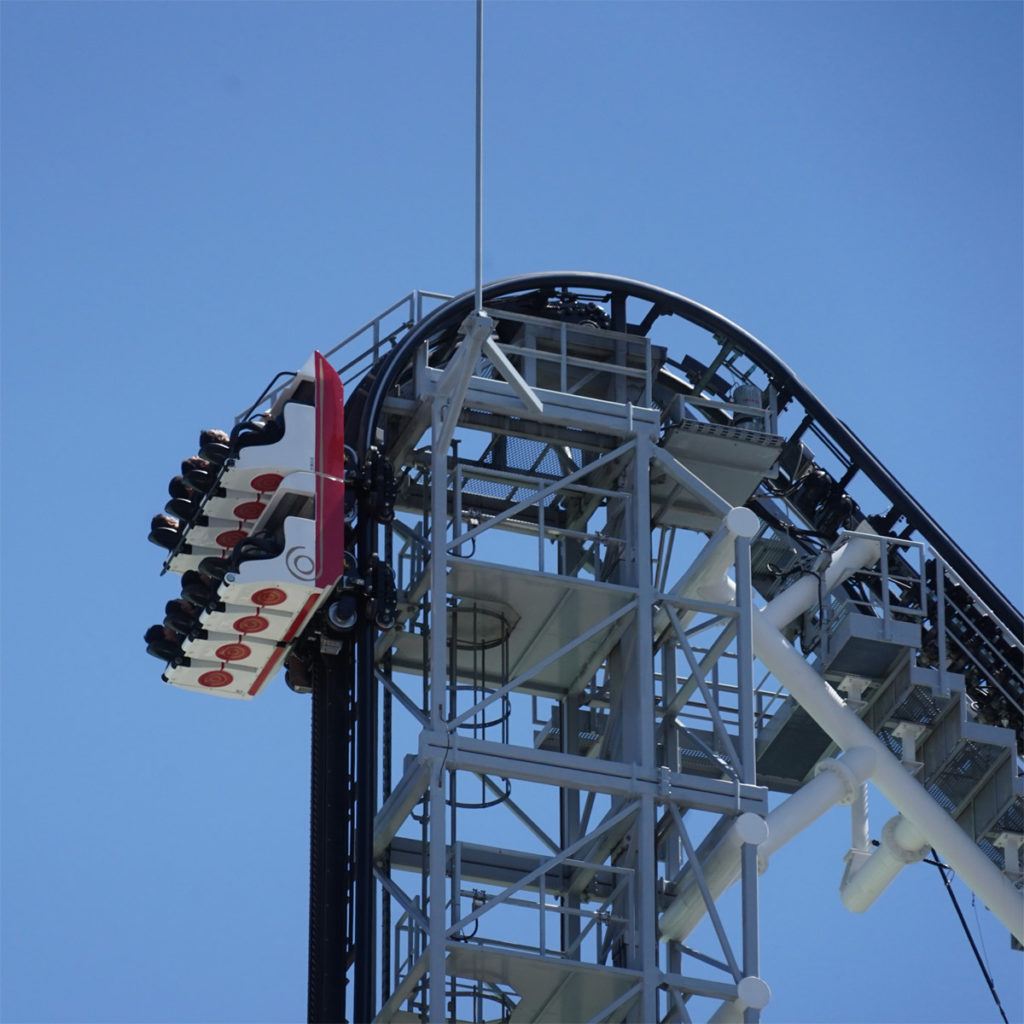
The best part about this ride was the pause at the top where our bodies were pressed against the safety bar while being given a couple of moments to admire the beauty of Mt Fuji set against the clear blue sky – the perfect mix of fear and exhilaration. After this temporary pause, we then fell into the beyond vertical 121-degree drop which was beyond insane before entering a series of three more inversions before the ride finally finished.
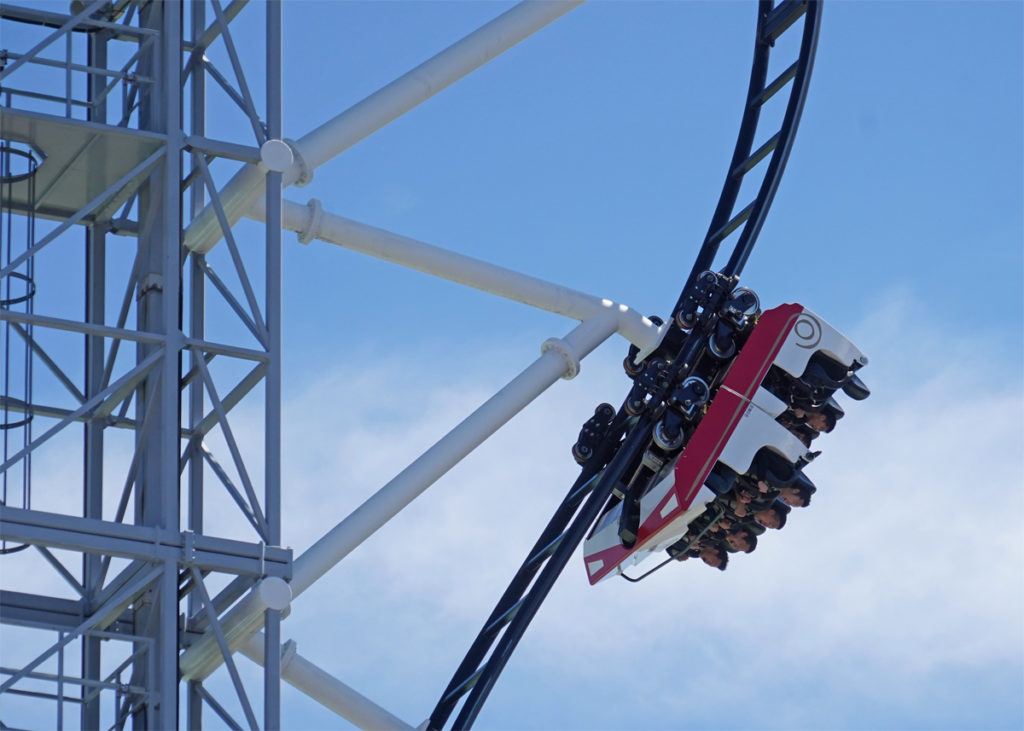
Takabisha is the newest of the Big 4 rides at Fuji Q and it shows. It felt very smooth, it was fast and had a fantastic mix of experiences.
Dodonpa Roller Coaster
Dodonpa is the most brutal and unsubtle rollercoaster I have ever been on. This ride is all about insane acceleration and speed. Formula 1 cars and Moto GP bikes can accelerate from 0 to 100 km/hr per hour in a little over 2 seconds. Dodonpa accelerates from 1 to 172 km/hr in 1.56 seconds so it accelerates more than twice as fast.
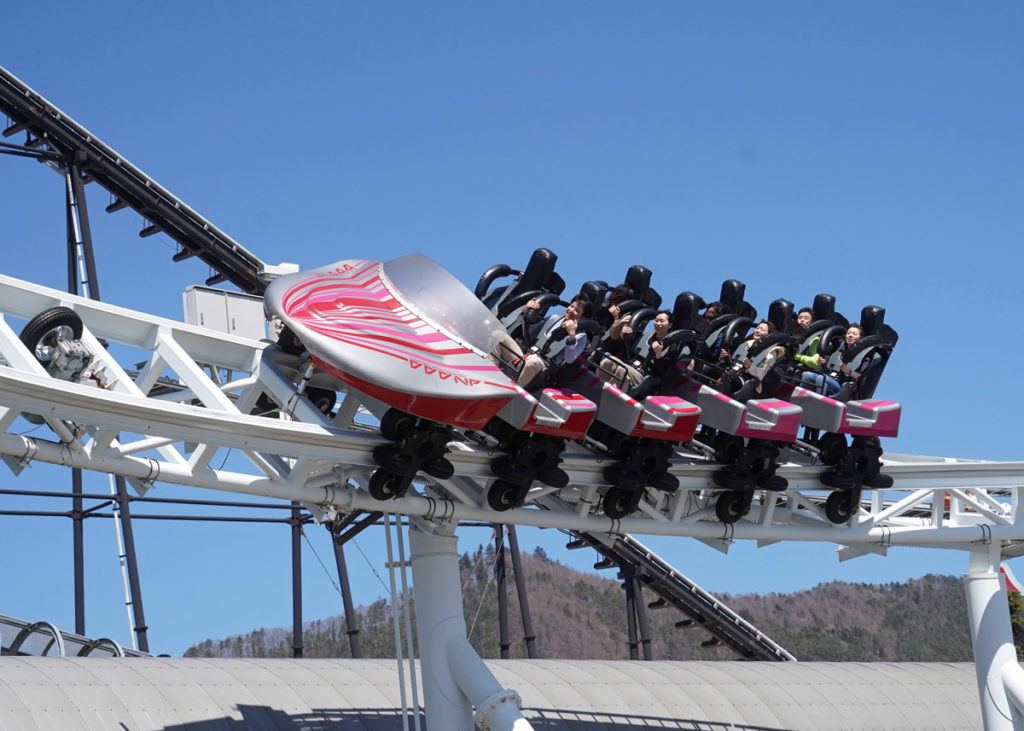
After loading into the Dodonpa coaster train we entered a launch area and were smacked in the face by the deep, percussive sounds of taiko drums playing a Do-don-pa beat from which the roller coaster gets its name. The menacing beat of the drums followed by a countdown to launch certainly helped build suspense. We were then fired out of the launch tunnel by the compressed air system used to launch the trains. It was like being shot out of a cannon as we were thrust back into our seats and raced along a straight section of track before banking into a large curve, followed by a 40-metre diameter loop which at its high point is almost 50 metres above the ground. After negotiating the loop, there were a couple more twists and turns before the vehicle decelerated back into the station and the ride was over.
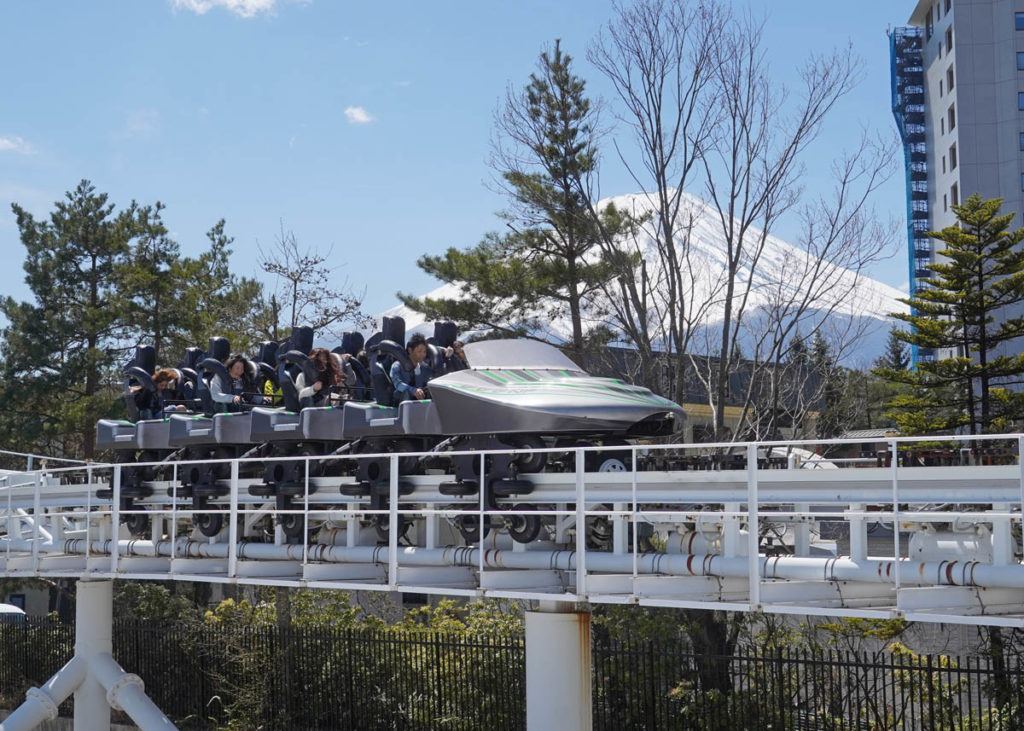
I have never before experienced the acceleration and g-forces this ride has to offer. I just wish the ride was a little longer.
Fujiyama Roller Coaster – The King of Coasters
When it first opened in 1996, Fujiyama set world records for being the tallest roller coaster and for having the biggest drop. While the coaster now feels a little dated the climb to the top of the rollercoaster, the top speed and the fact that it’s an extremely long ride means that Fujiyama can still offer a fantastic experience.
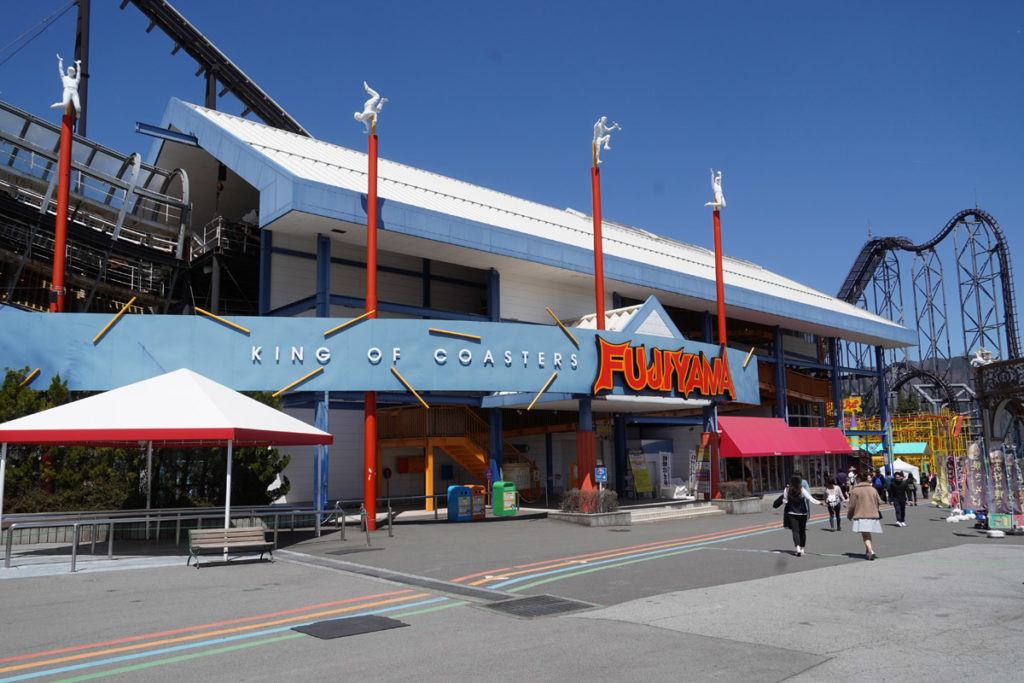
As we climbed the hill at the start of the ride, we watched the signs marking off high we were above the ground (20 metres, 30 metres, 40 metres) while seeing the ground fall away behind us. The relentless “click click click” noise of the anti-rollback device provided an ominous background noise to the slow and relentless climb. When we reached the top the view is spectacular and then we were thrown through a seemingly endless series of loops, twists and turns at extremely high speed.
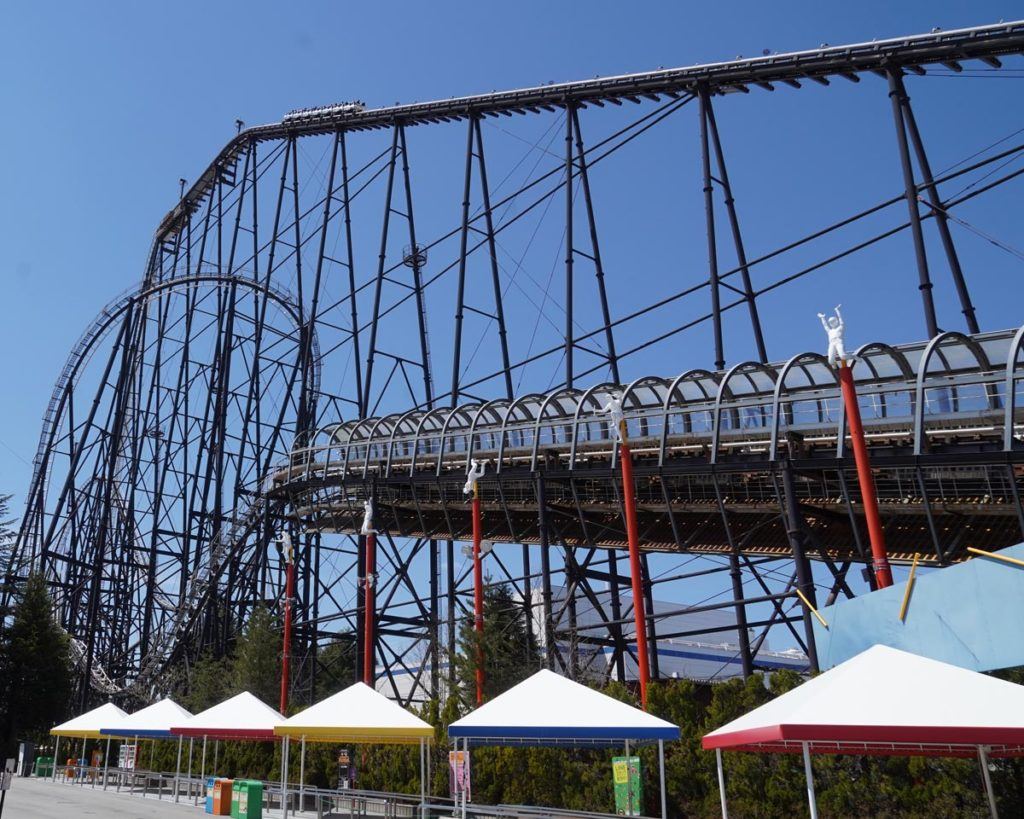
For a rollercoaster that is now over 20 years old, Fujiyama is still a whole lot of fun and well worth going on. It just doesn’t quite measure up to what Eejanaika, Takabisha and Dodonpa have to offer.
Other Fuji Q Rides
Nagashimasuka
It’s not just the four main rollercoasters that are extreme and over the top at Fuji Q – so are the water flume rides. On both Nagashimasaka and Cool Jappaan you can expect to get very, very wet particularly if you are brave or foolish enough not to use a poncho. The first thing you notice when you are near Nagashimasuka is the gigantic pair of 10-metre tall golden lucky cats.
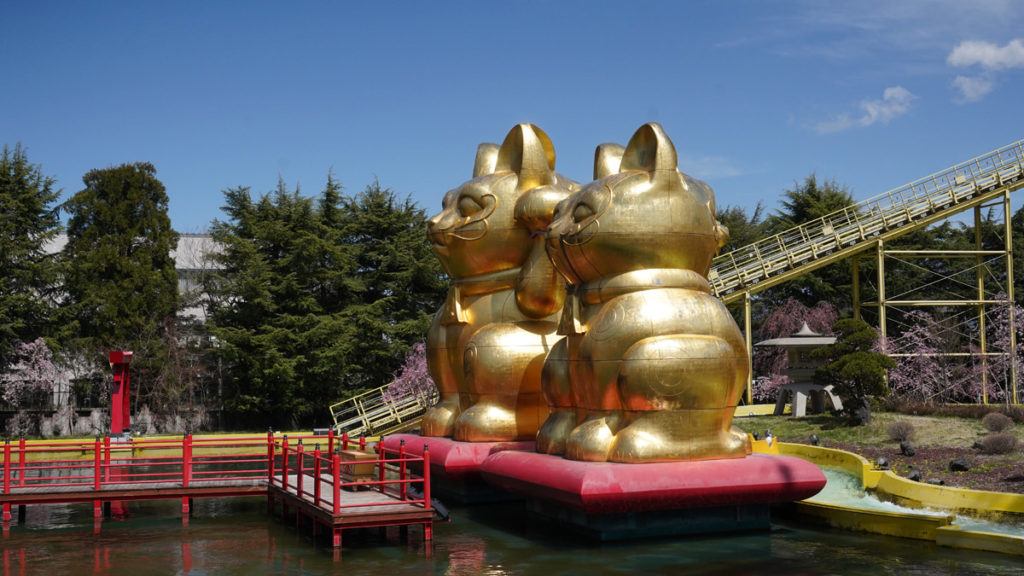
As we entered the ride area the next thing we noticed were the warnings that we were about to get very wet so we decided to buy some ponchos.
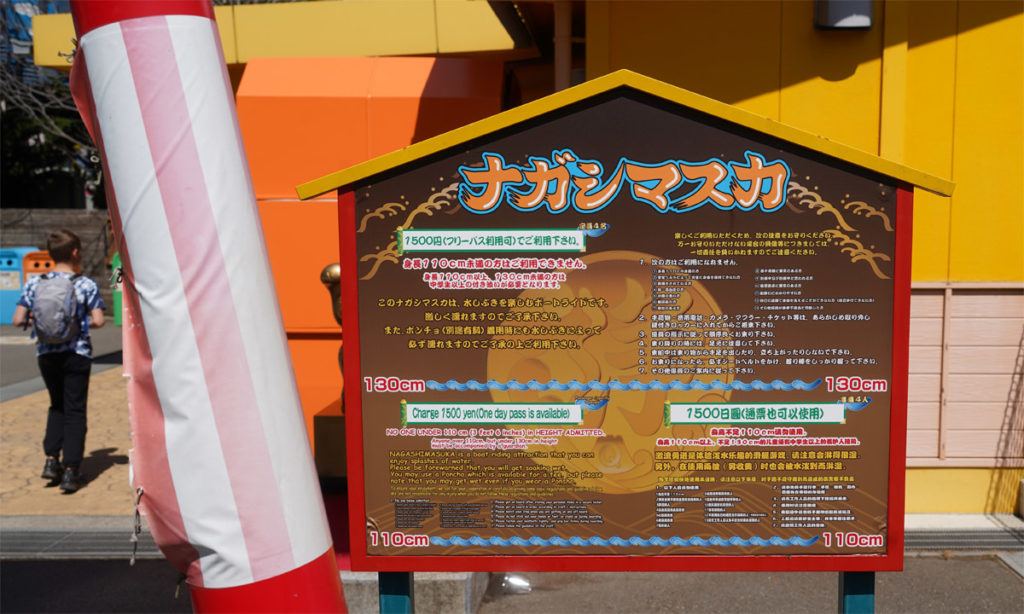
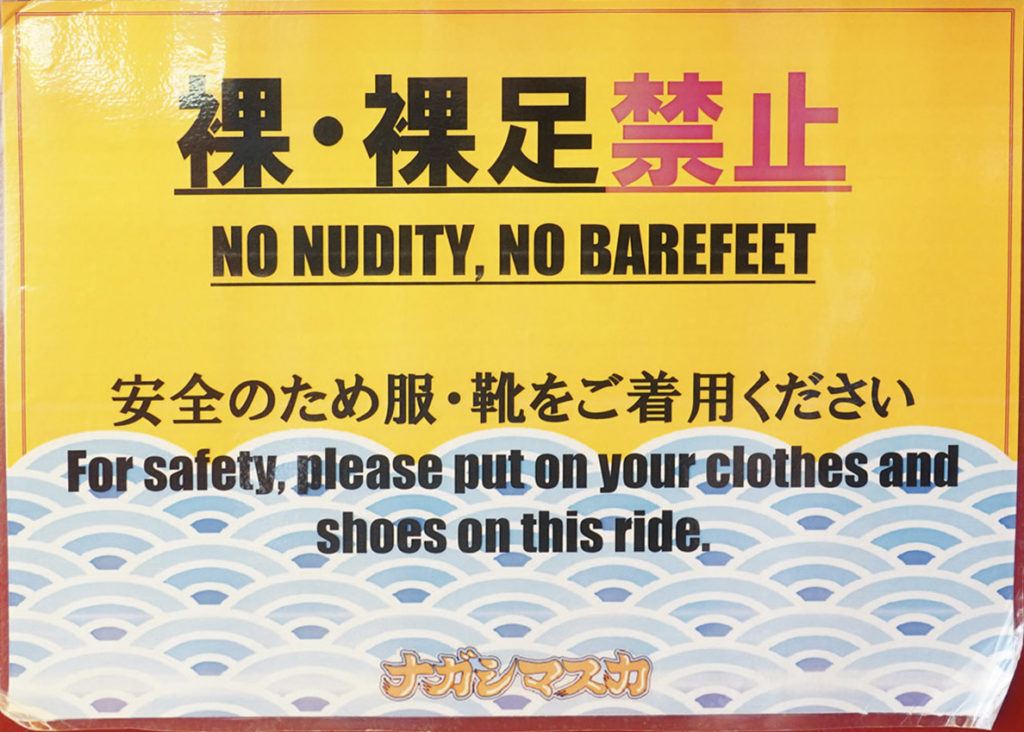
After boarding the raft we were first hoisted up a hill that reached a height of 18 metres above the ground.
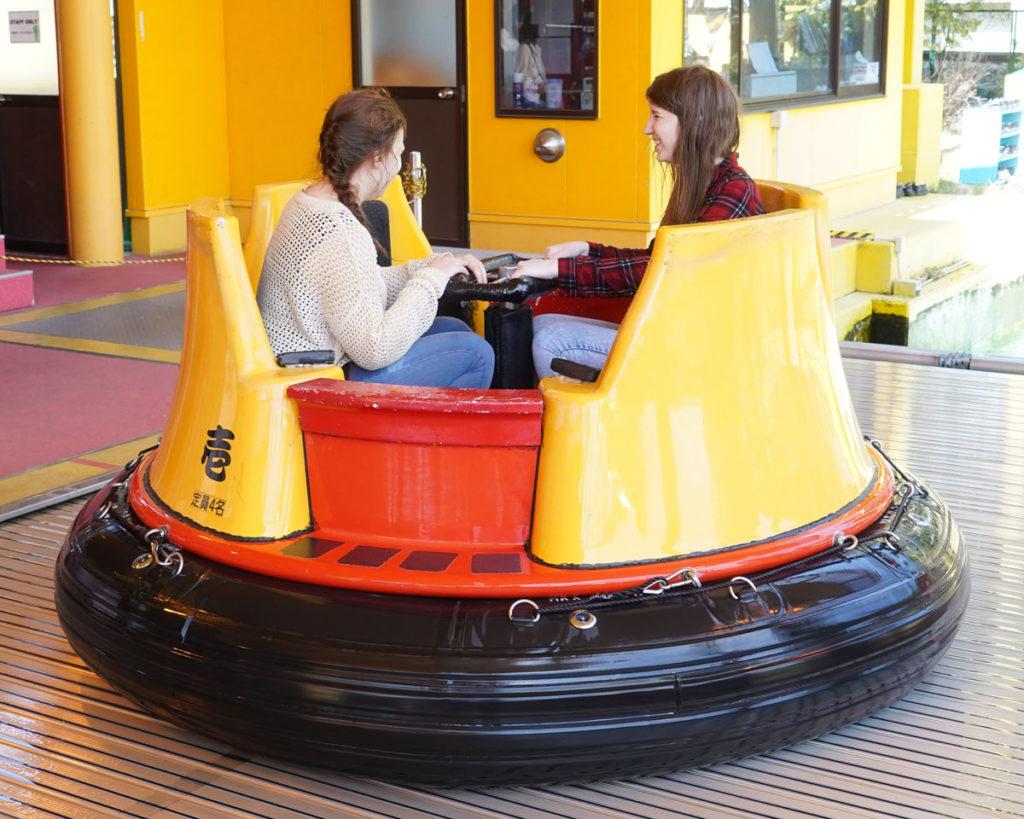
The course we followed was 500 metres long and filled with plenty of twists and turns and an excess of water that was splashing everywhere.
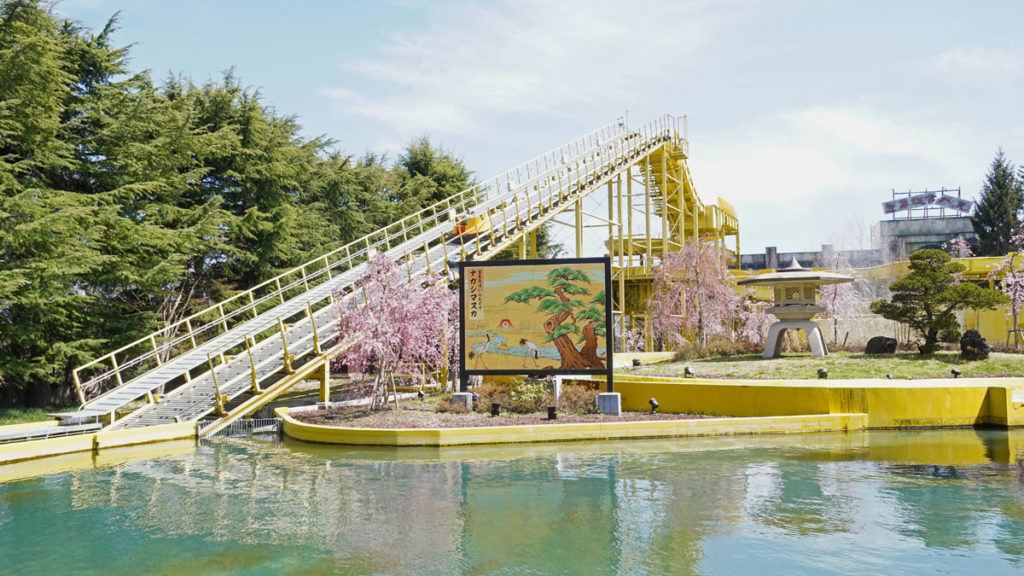
The raft goes surprisingly fast for a water ride reaching speeds up to 29 km/hr. Thanks to my poncho, a bit of luck and a strategy of lifting my legs so my feet weren’t touching the floor of the boat I managed to stay somewhat dry. That was until we entered the final section of the course where we were flushed down what can only be described as a giant toilet bowl. Suddenly, my runners were completely soaked which meant that for the next hour or two I was squelching around the park with extremely wet shoes and socks. My son found this very amusing as he managed to completely avoid getting wet, mainly due to his shorter legs. However, later on, I would gain some element of petty revenge on the Cool Jappaan water flume ride.
Cool Jappaan
Firstly, sorry for the weird spelling of Cool Japan but that’s the way it’s spelt on the English version of the park map. The Cool Jappaan water flume ride is in many respects a much simpler ride than Nagashimasaka. The course is only 285 metres long, making it a bit more than half the length of Nagashimasuka. It also doesn’t have all the twists and turns of Nagashimasuka. You simply go up then you come back down.
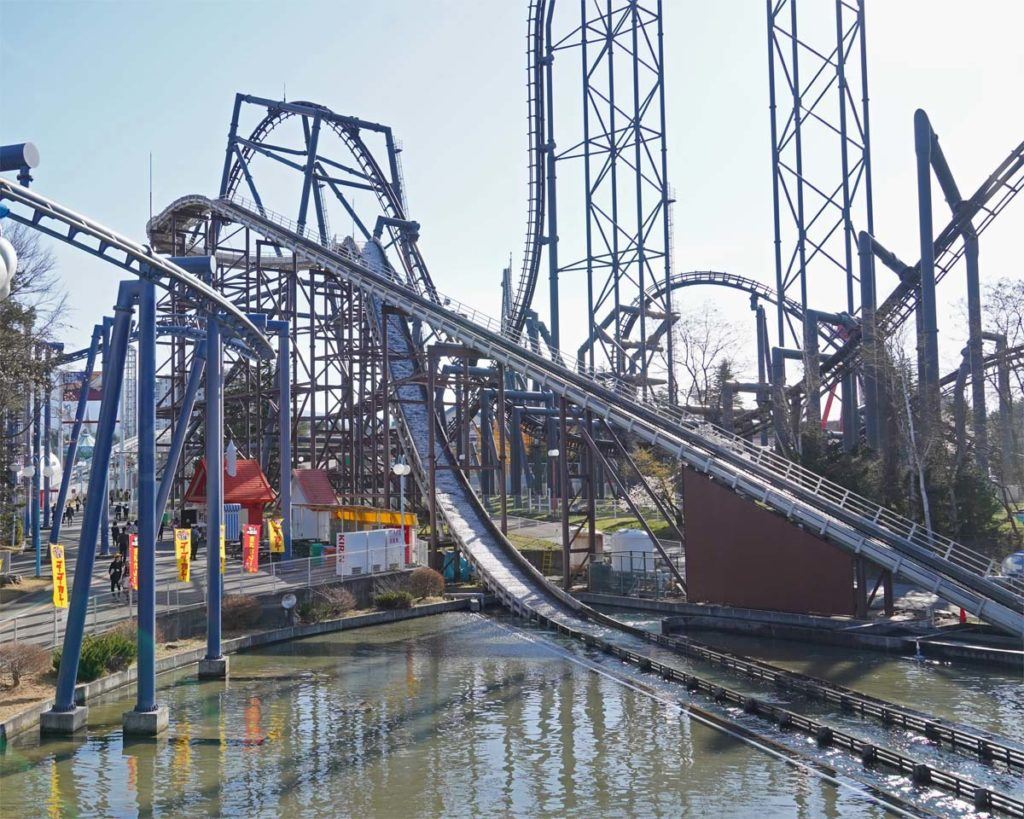
What it does have compared to Nagashimasuka is height, speed and angle of descent. The top of the course is 30 metres above the ground, you reach a maximum speed of 80 km/hr and the tilt of the downward section is 40 degrees. These factors translated into a very big splash when our raft reached the bottom of the course.
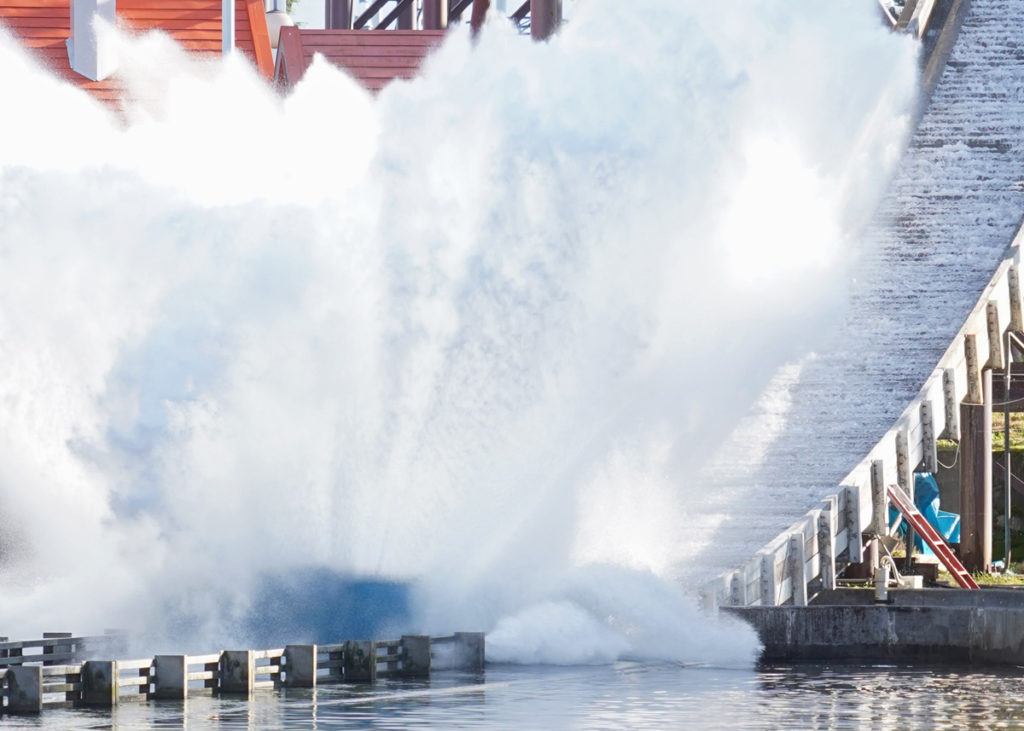
The splash that is created is 18 metres high which in practice turns your world completely white for a few seconds. You are certain to get extremely wet without a poncho.
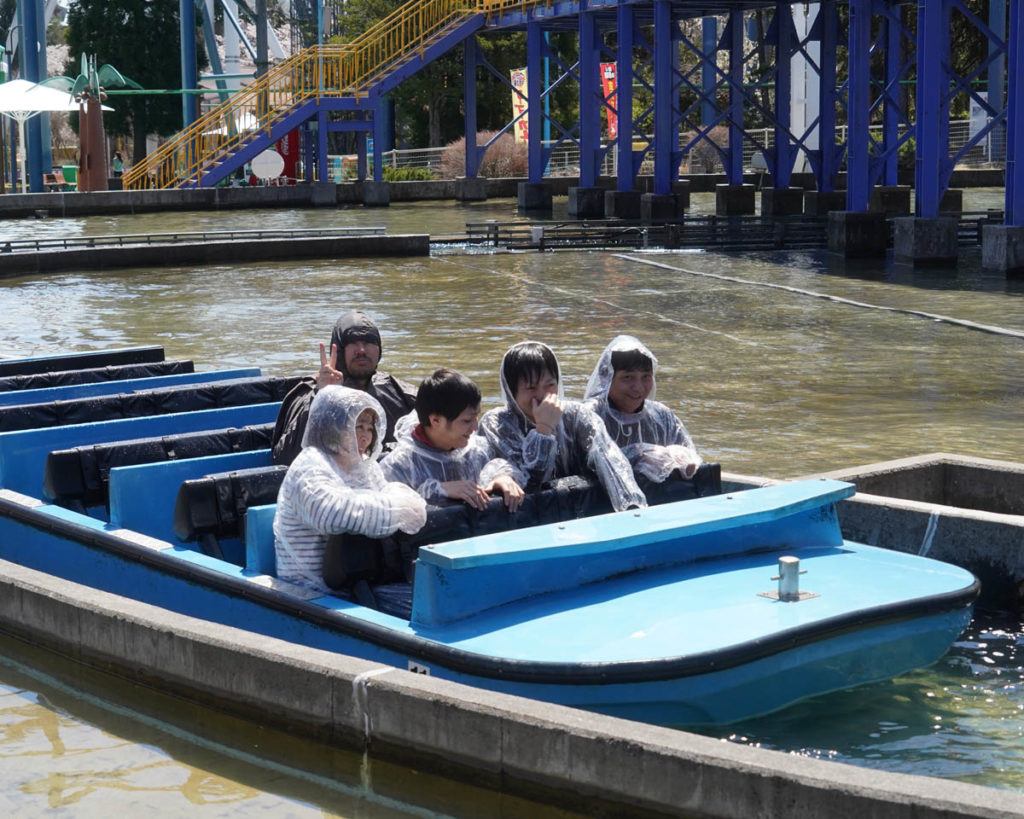
This time both of us ended up with incredibly wet runners. As this was our last ride of the day before heading back to our accommodation we both squelched out of Fuji Q with sodden shoes and socks.
Tentekomai
When on the Tentekomai you get to pilot an aircraft using the controls located on the aircraft’s wings. You can choose to take the scenic flight option or aggressively manoeuver the craft to perform all sorts of air tricks such as a series of 360 degree spins guaranteed to lift your heart rate.
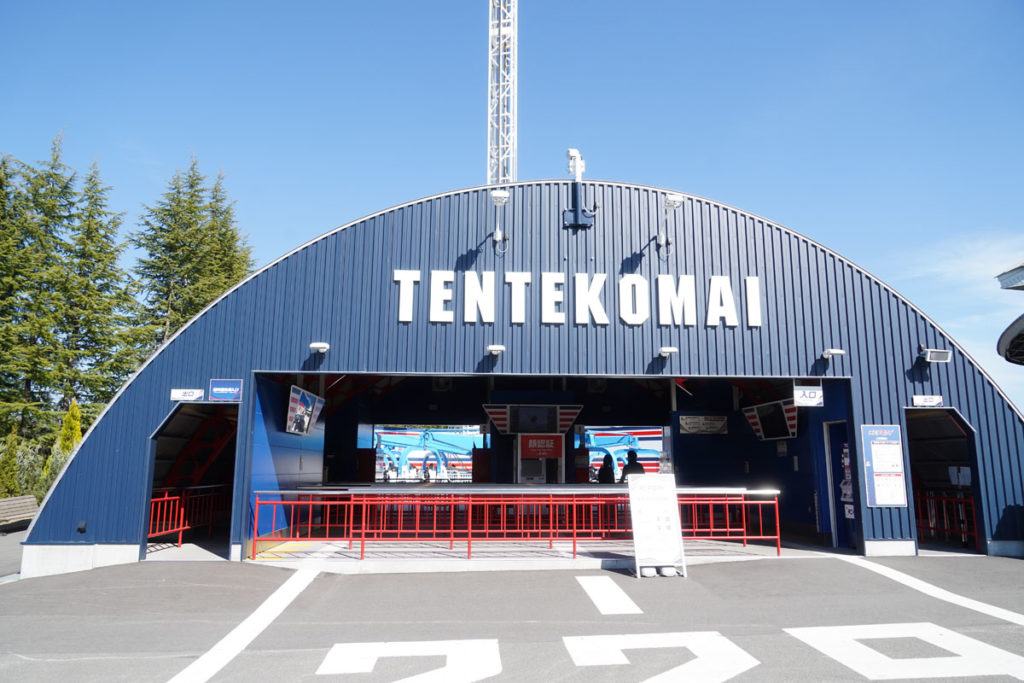
We have been on a very similar ride called Tail Spin at Dreamworld in Australia but as with most rides at Fuji Q, Tentekomai elevates this type of ride to a whole new level. For example, Tail Spin reaches a maximum height of 22 metres while Tentekomai’s maximum height gets to 32 metres with stunning views of Mt Fuji thrown in as an added bonus. I found this ride to be a lot of fun as I was able to perform quite a lot of tricks. My son was a little more disappointed as he wasn’t able to spin his aircraft perhaps due to the fact that he only weighs about 40 kilograms which meant he wasn’t able to throw his body into the turns as much.
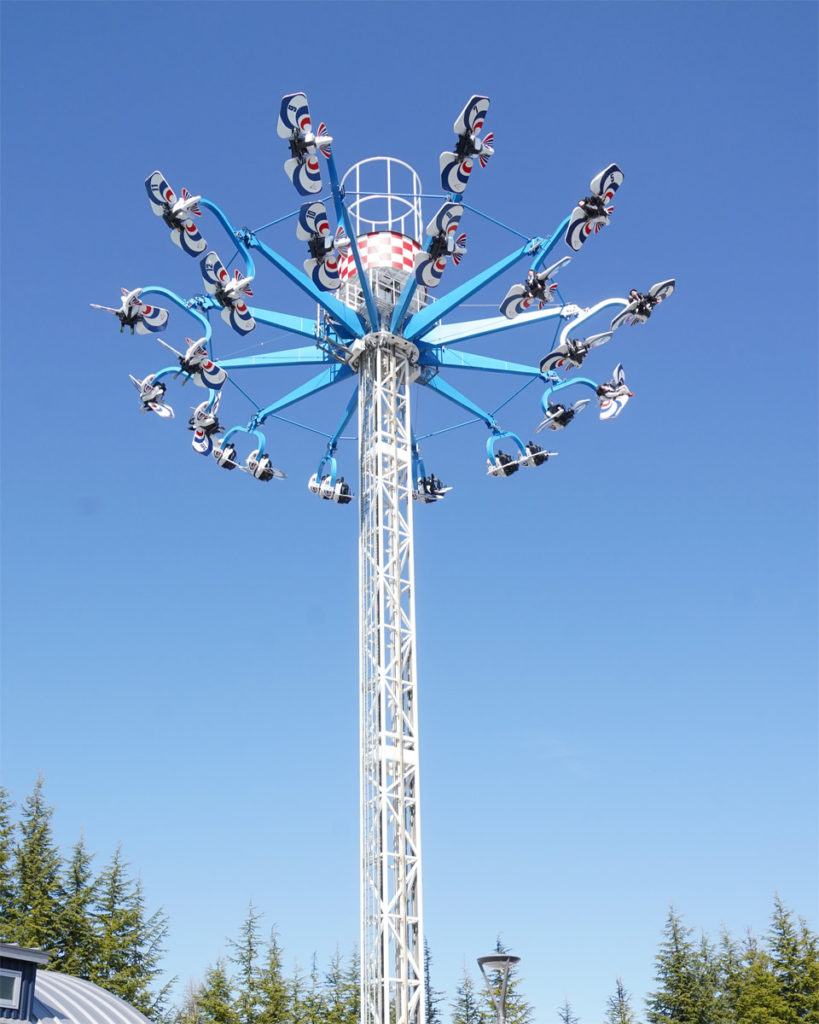
Mad Mouse
There’s probably no need to try out Fuji Q’s Mad Mouse ride if you’ve been on a mad mouse/wild mouse ride before as they seem pretty similar. However, in our case, neither my son nor I had ever been on a Mad Mouse ride before so the experience was quite surprising. Mad Mouse rides don’t look particularly high or long and they don’t seem to go very fast. We honestly went on this ride just to experience a bit of childlike silliness.
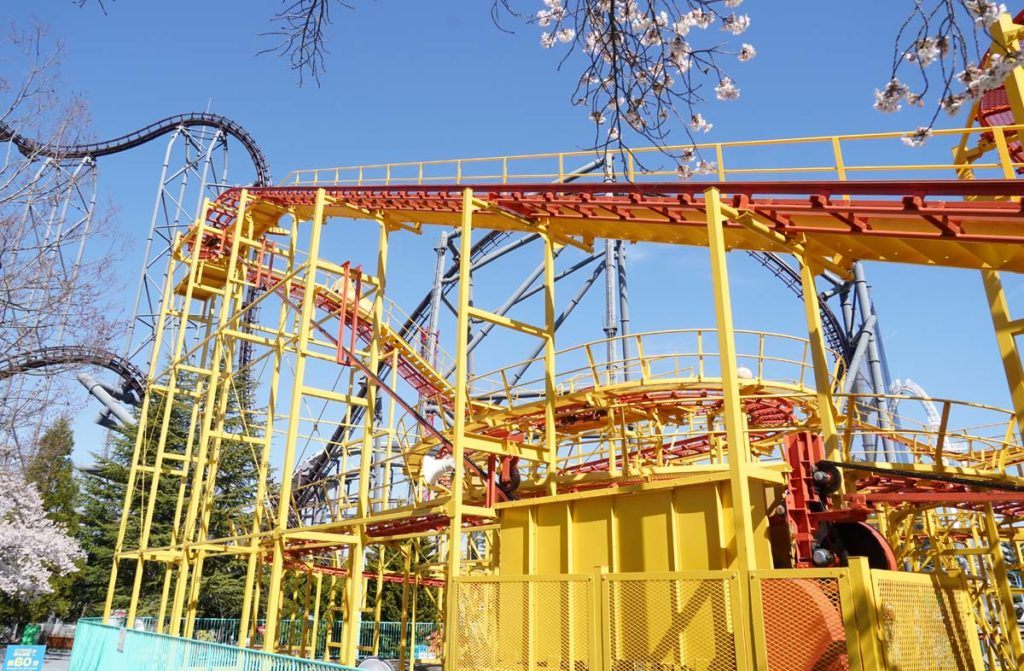
While the ride looked tame, in practice it was rough, violent and a whole lot of fun. Don’t expect anything like banked turns on a Mad Mouse ride. There is absolutely no place for such subtleties. We instead experienced an endless series of extremely violent turns as we were tossed left and right, forwards and backwards. On at least one occasion it felt like my stomach was trying to relocate down towards my toes, and I’m sure the lateral G-forces were quite high during the constant sharp left and right turns.
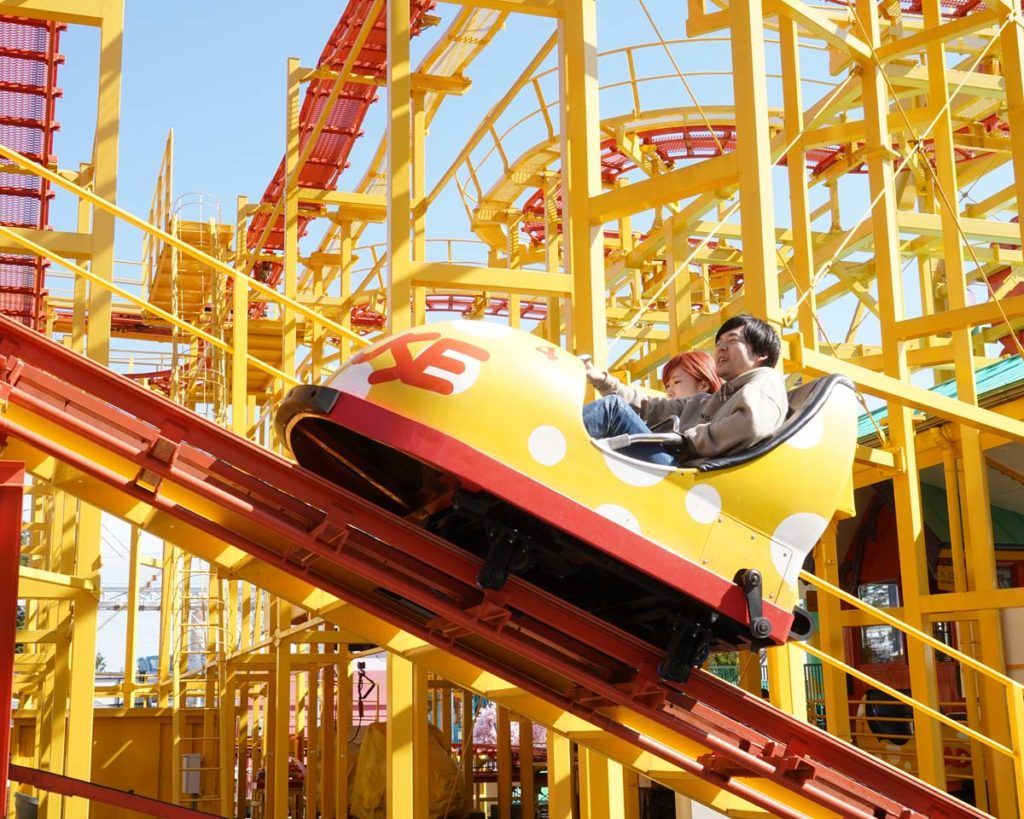
Don’t write off Mad Mouse or Wild Mouse rides as something that’s just for kids. If you’ve never experienced this style of theme park ride before, make sure you don’t miss out on giving Mad Mouse at Fuji Q a go.
Tondemina
I quite enjoy pendulum style rides like Tondemina and so as expected we had fun on the Tondemina. However, it doesn’t stand apart in any way from other pendulum rides except for the fact that the views over the park and the surrounding area are excellent.
As with other pendulum rides we have been on, we sat down on an outward-facing seat with our feet hanging down. The seats are set up in a circular/disc configuration that looks a bit like a pizza. When the ride started the pendulum started to swing back and forth while the disc started rotating.
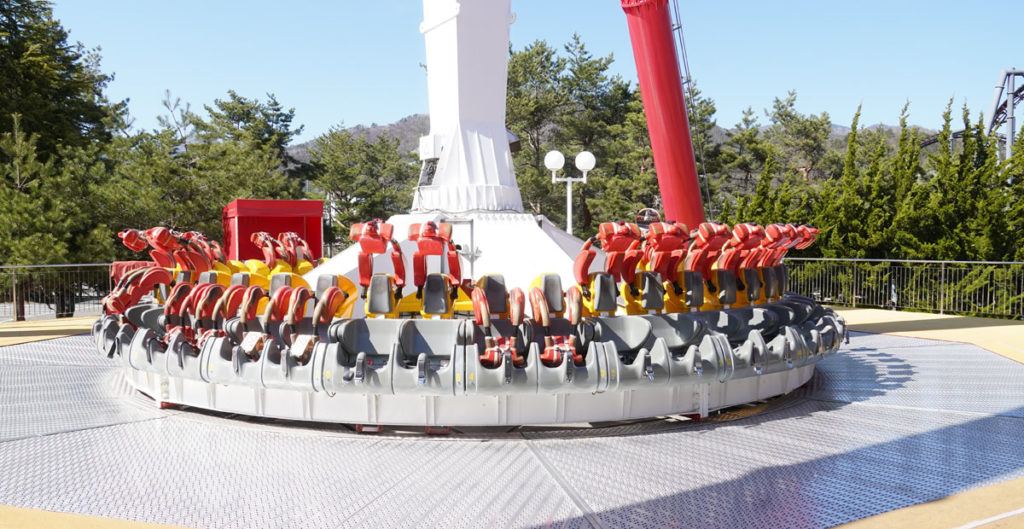
At full height, the disc is 43 metres above the ground and reaches a maximum inclination of 120 degrees on both the left and right-hand sides. Tondemina reaches a top speed of 102 km/hr.
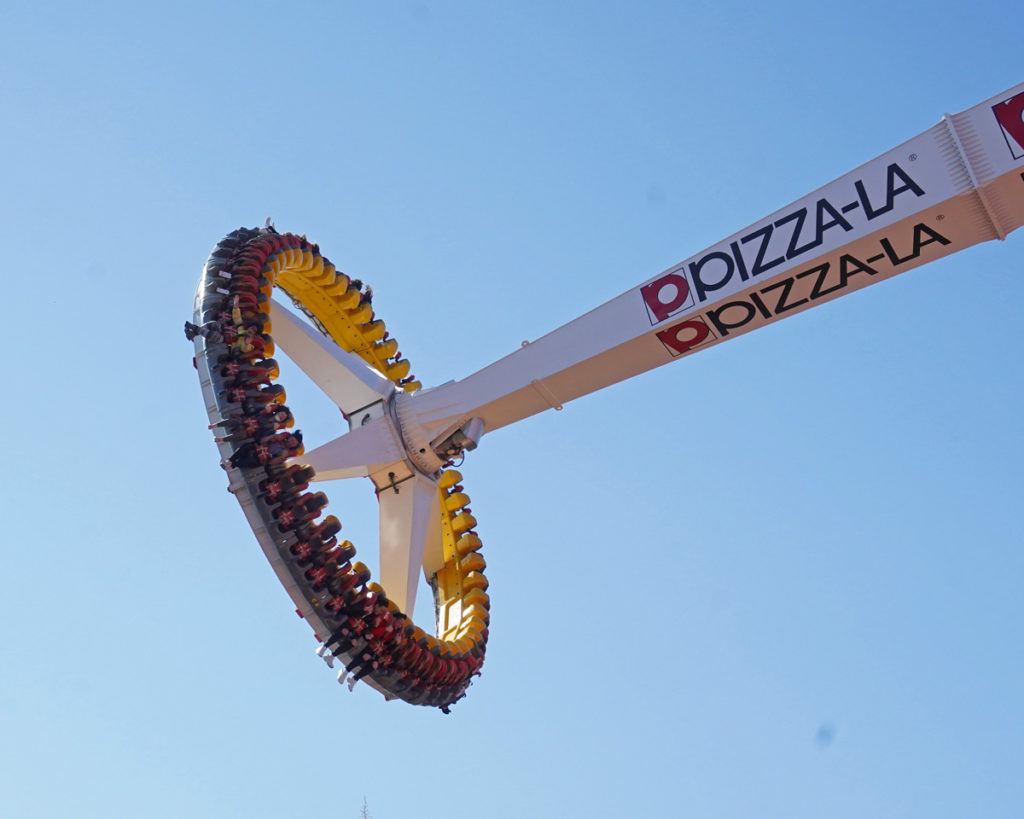
If you are pressed for time and have been on a pendulum ride before there’s no need to go on the Tondemina. However, if you have time to spare and have never tried out a pendulum ride, give Tondemina a go.
Red Tower
The Red Tower is a pretty conventional drop tower-style ride. For those of you who haven’t experienced drop towers, you sit in a disc-like gondola carrying riders. The gondola is then lifted to the top of a large vertical structure. The gondola is then released causing it to free-fall down the tower for a period of time before the braking system is engaged.
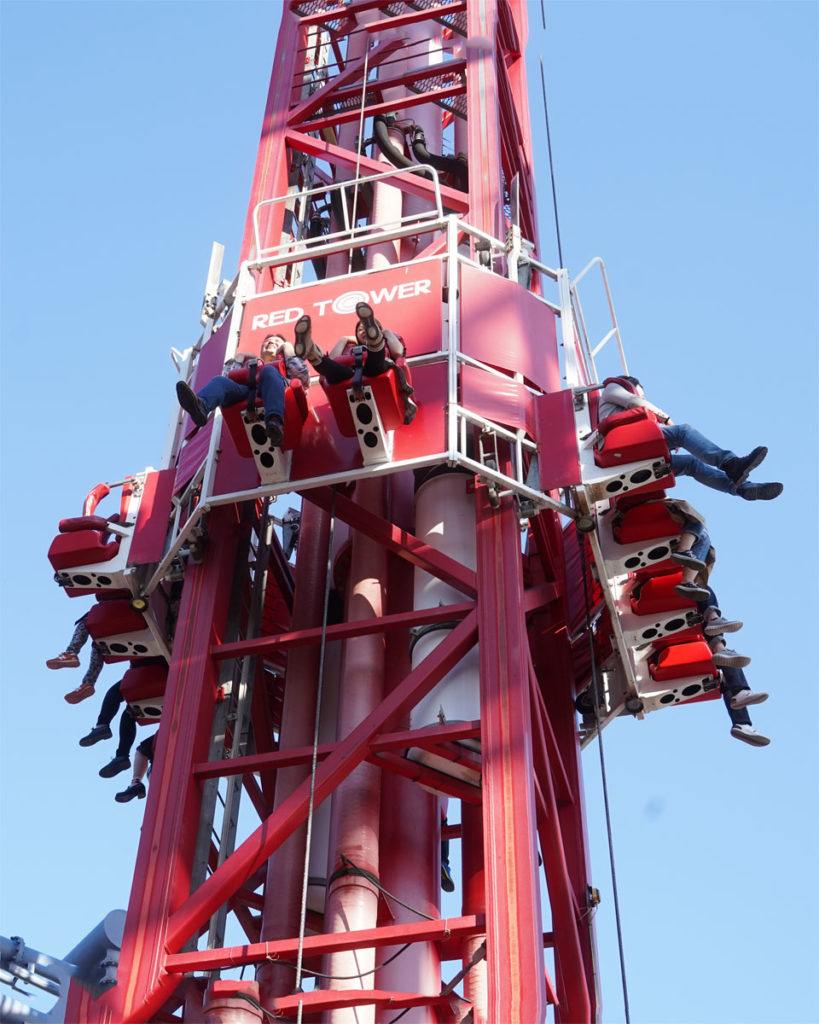
The experience of free fall is always fun along with the sense of your body being lifted off your seat. We definitely enjoyed riding the Red Tower, but a bit like the Mad Mouse and Tondemina, there is nothing particularly unique about this ride that sets it apart from other drop tower rides. For example, it’s only 52 metres tall which is nowhere near the height of the tallest drop towers. In contrast, we had previously ridden the Giant Drop at Dreamworld in Australia which is 119 metres high placing it in the top 3 tallest drop towers in the world. If you’ve been on a drop tower ride before don’t feel like you need to try out the Red Tower unless you have plenty of time on your hands or you love this style of ride.
Fuji Airways
My son and I really enjoyed the Fuji Airways ride. It opened in 2014 and was Japan’s first flight simulation ride.

One of the things we really enjoyed about the experience was the sense of humour which started from the time we queued up and continued through the pre-flight video.
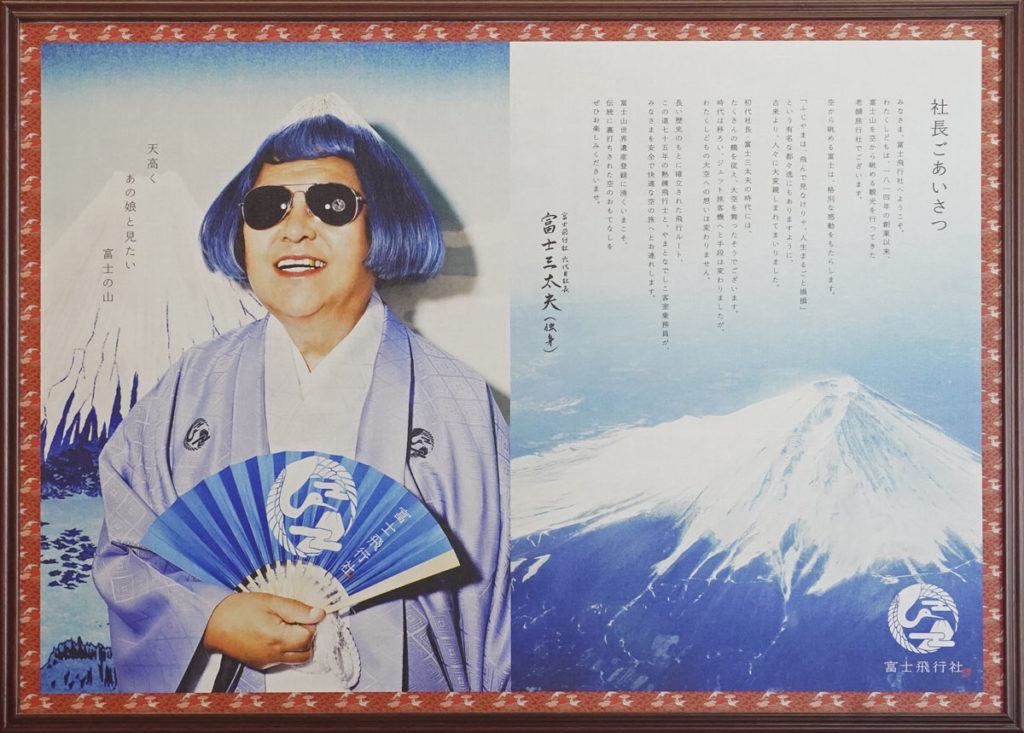
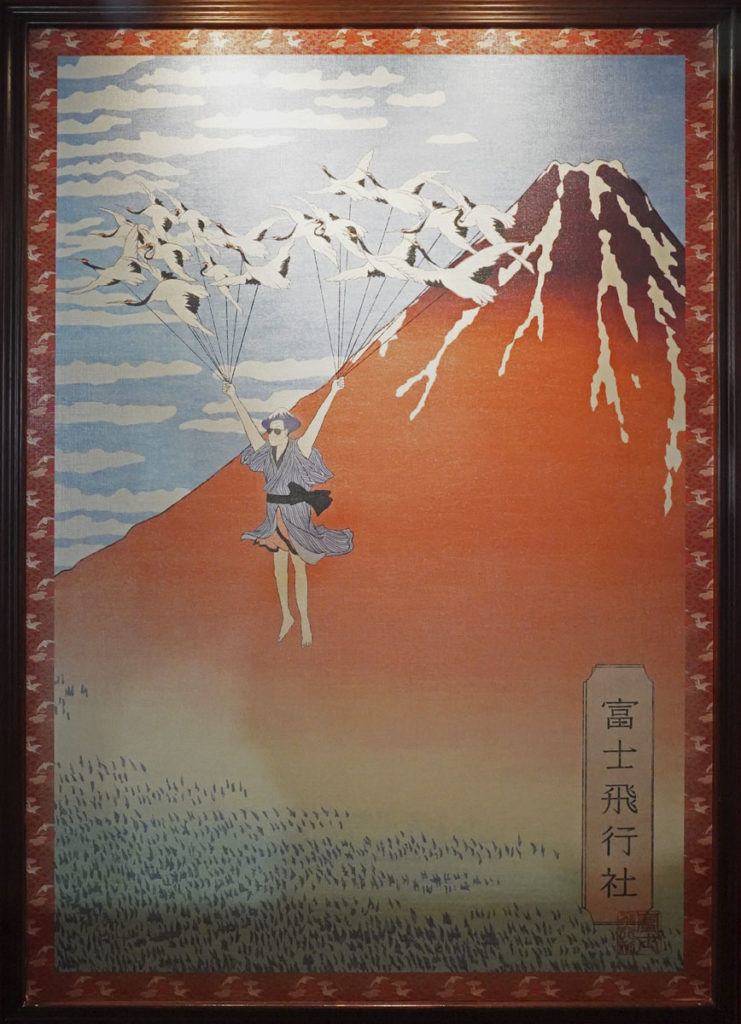
The footage of Mt Fuji through the different seasons was stunning with much of the more recent footage filmed in 6K with motor paragliders and drones. The whole experience was also very immersive and included features such as the wind blowing, the splashing of a lake surface and the fragrance of forests and flowers to add to the realism of the ride.
Don’t expect a thrill ride but I would highly recommend trying out Fuji Airways if you love flight simulators or would like to experience the beauty of Mt Fuji from a different perspective.
VR Fujiyama vs Dodonpa
Of all the rides and experiences at Fuji Q, VR Fujiyama vs Dodonpa was the most disappointing. In truth, it was close to a waste of time. We entered a tent that housed the two VR rides, sat in our seats and put our headsets on. The seats were static which detracted from the experience and there was a small desk fan mounted in front of us to simulate the wind. The ride used Galaxy Gear VR headsets and the quality of the footage wasn’t great.
If you want to get a sense of what the rollercoaster courses for Fujiyama and Dodonpa are like before trying out the actual rides or have zero interest in going on the real rides but want to get a small taste of them, trying out the VR versions may make some sense. Otherwise, there is just no point in trying out VR Fujiyama vs Dodonpa because the real experiences are just so much better.
Desperation Fortress 3
Desperation Fortress 3 is considered to be one of the most difficult escape rooms in the world. An escape room is a game in which teams of players work together to discover clues, solve puzzles and complete tasks in a limited amount of time in order to progress to subsequent stages of the game. Reportedly, something in the order of 0.001 % of people succeeds in solving all the puzzles in Desperation Fortress 3 in the allotted time.
This attraction should have been a really enjoyable change of pace after experiencing a whole bunch of rides. Being able to run around and stretch our legs while solving puzzles cooperatively sounded like a great idea. Unfortunately, in reality, it wasn’t as much as we thought it would be and it was largely our fault.
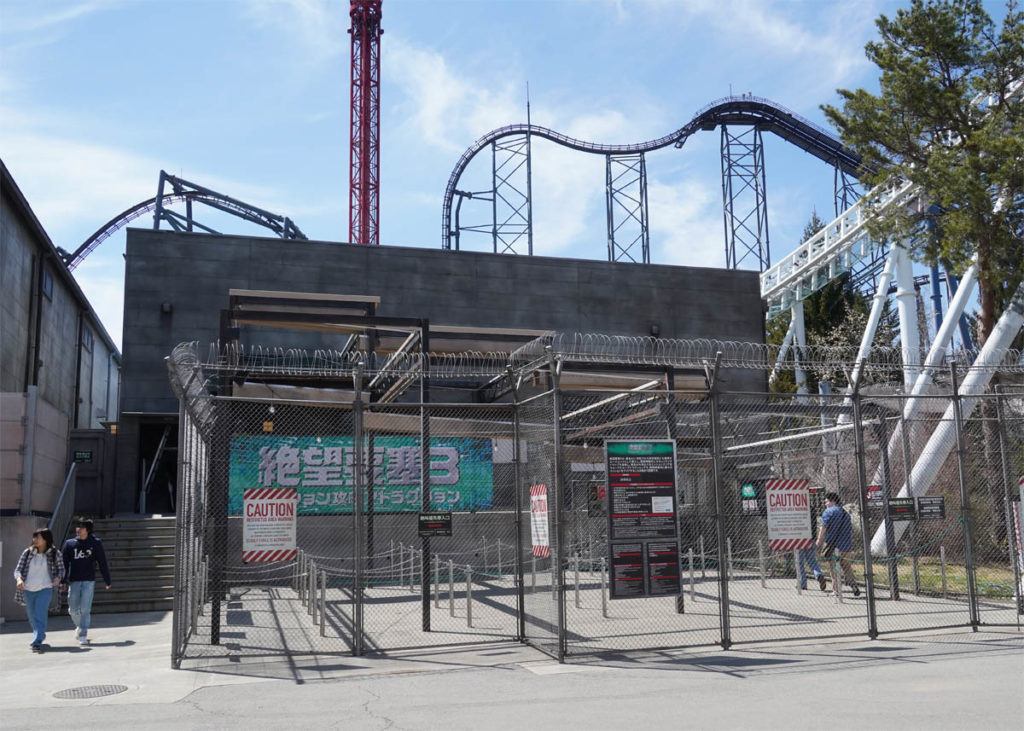
The premise behind this particular escape room is that you are stuck in a fortress that has been taken over by a rogue AI. Your mission is to retake control of the fortress by solving a series of puzzles. After the initial introductory video to get us up to speed with the storyline and mission, we were given a small handheld device that we had to carry around the fortress. The default language for the device was Japanese but it was easily reset to English and can accommodate other languages as well. As we entered the fortress, the device was designed to give us clues and also acted as a key to scan different parts of the maze. We really didn’t take on board the clues that our device was giving us until it was too late and our time was almost up. In the last couple of minutes of our allotted time for stage one, we were running like crazy trying to complete the initial set of puzzles. Unfortunately, we ran out of time and struck out on the first stage and so had to exit the fortress with our heads held low … but I’m sure we were not the first.
Labyrinth of Fear
There were a number of other rides and experiences I would like to have tried if we’d had a bit more time. One thing I would like to have experienced was the Labyrinth of Fear, but it would have required me to convince my son who’s not a big fan of jump scares.
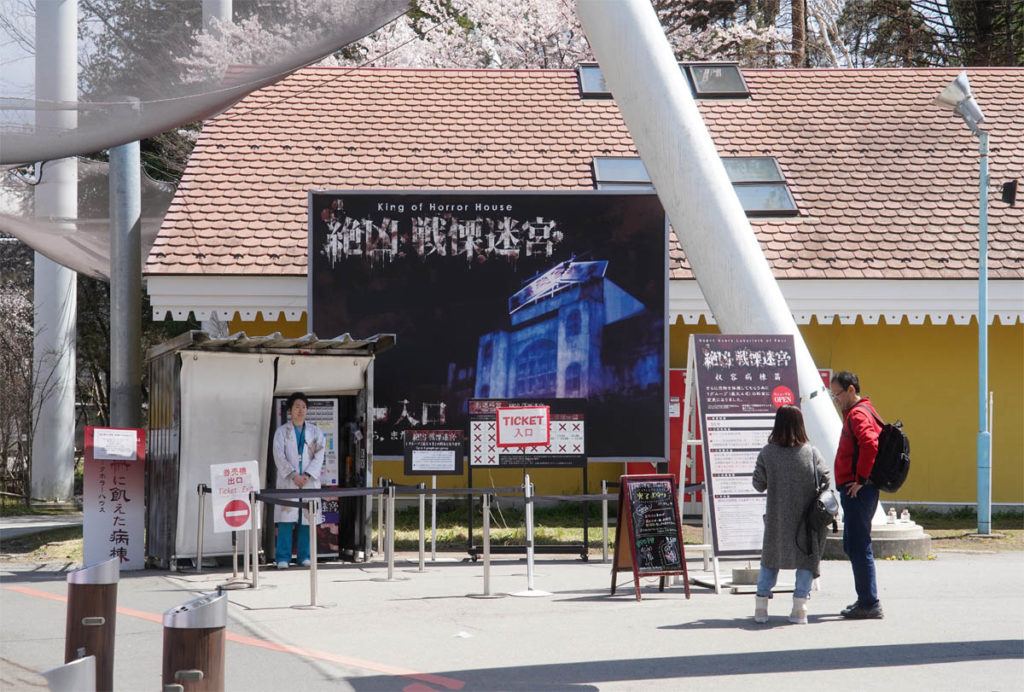
The Labyrinth of Fear is a 900 metre long haunted house which is reportedly one of the scariest houses of horror in the world. The setting for this particular house of horror is a haunted hospital and it uses real people to scare you out of your skin. You are allowed to roam around freely and explore the hospital. It takes about 50 minutes to negotiate your way through the Labyrinth of Fear. If you want to dial down the fear factor, apparently you can buy an omamori (lucky charm) that glows in the dark and encourages the actors to tone down the scares.
Evangelion World
My kids and I also enjoy Japanese anime so it’s a shame we missed out on Evangelion World. Evangelion World is an interactive anime exhibition that features life-size models, artwork, displays and lots of interactive experiences.
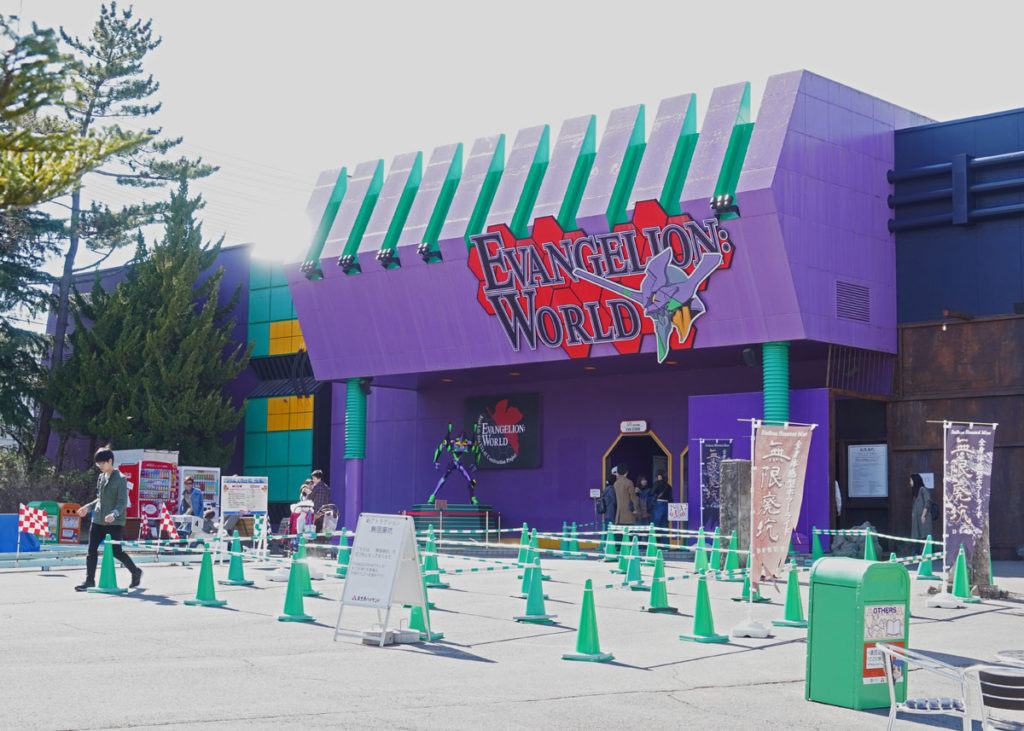
Other rides and experiences
You probably would need a couple of days to try out everything the park has to offer even with the help of Zekkyo priority passes. As mentioned earlier in the article, we sampled 13 rides and attractions in about 6 hours and Fuji Q has over 40 attractions. Here are a few photos of some of the attractions we didn’t get to experience.
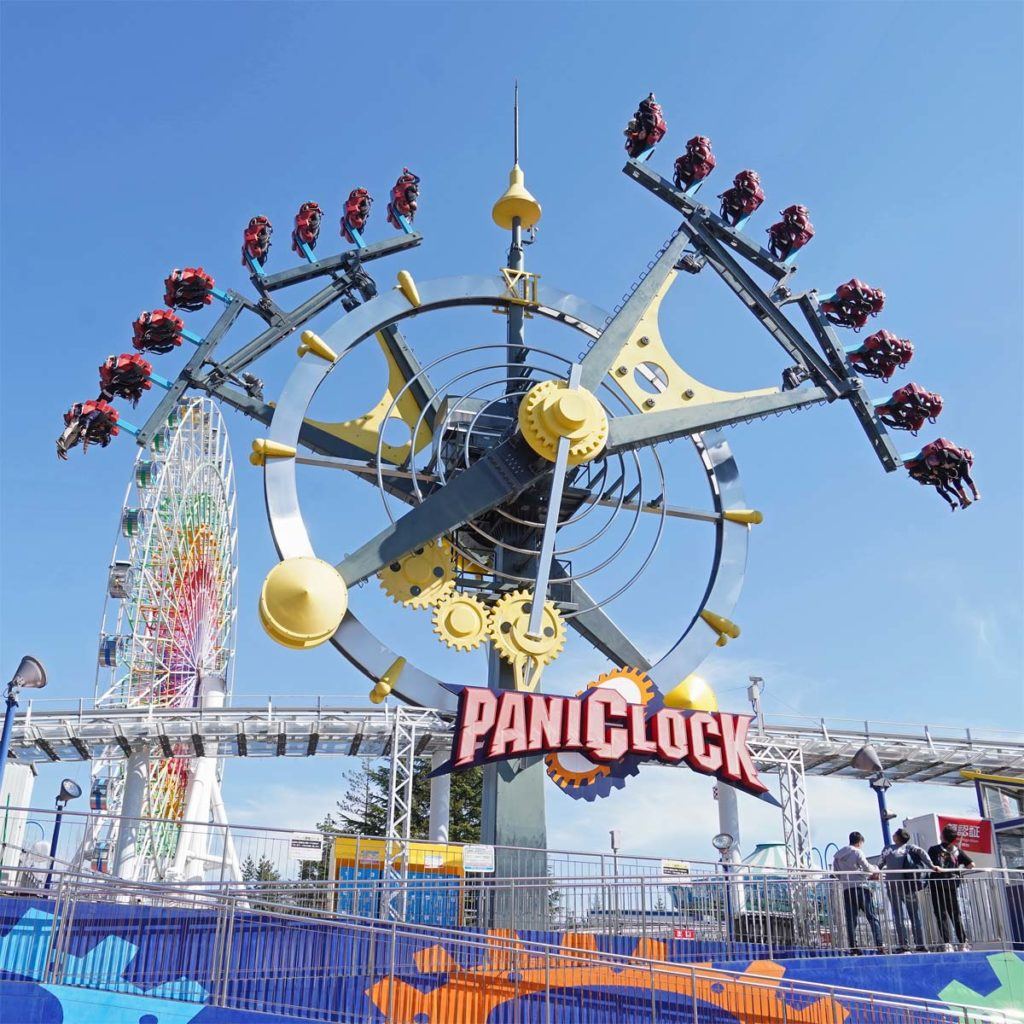
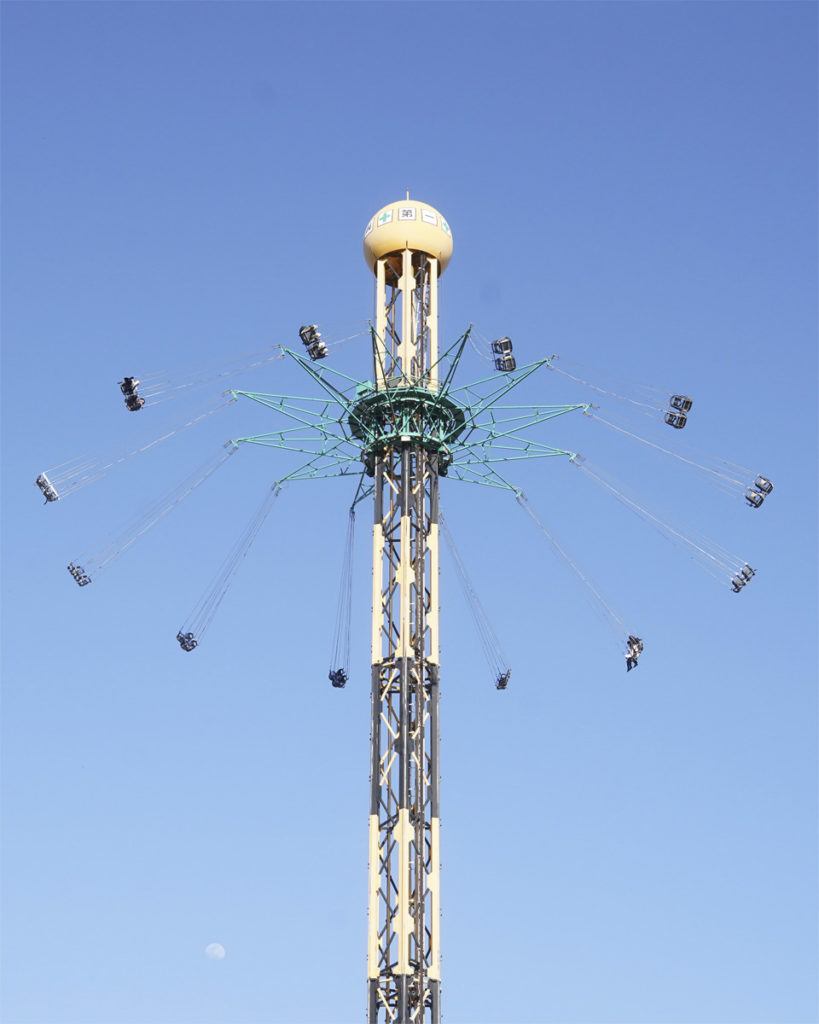
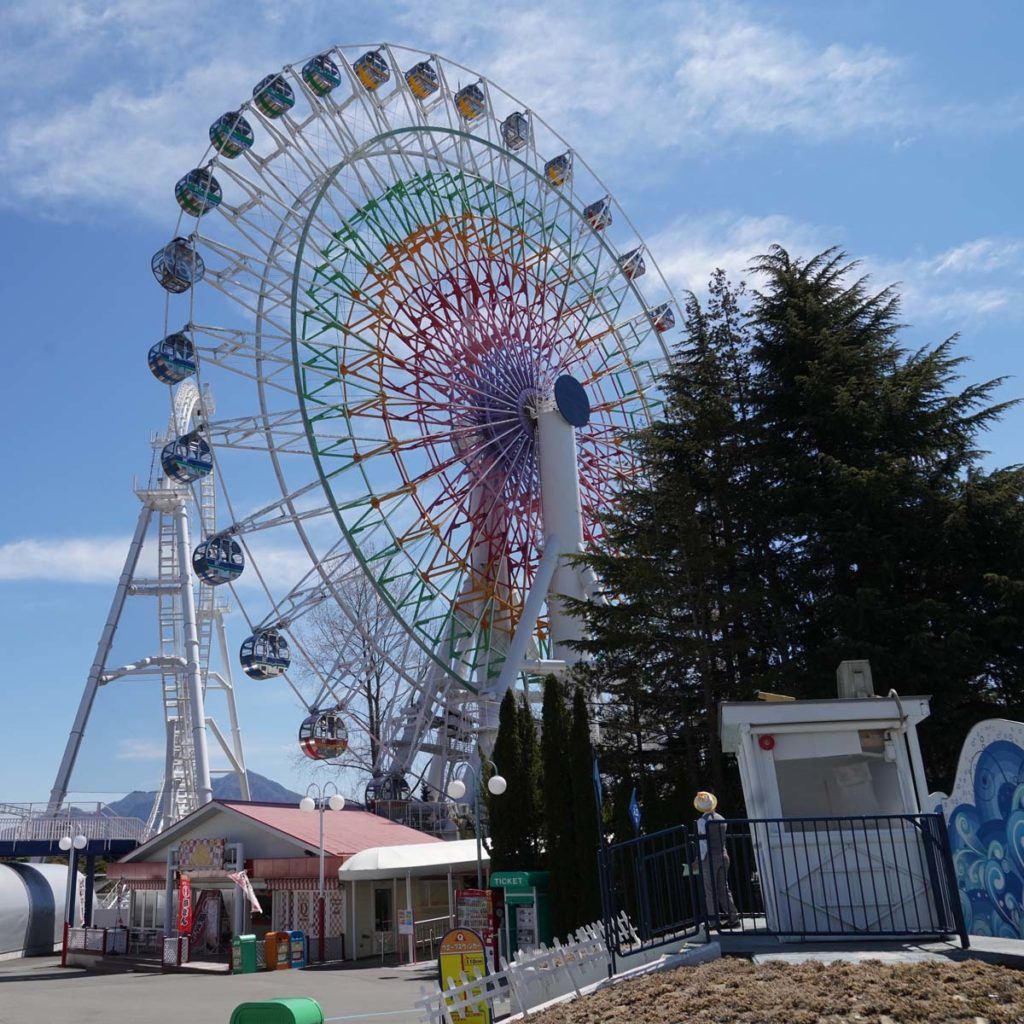
Food at Fuji Q
There are plenty of food and drink options at Fuji Q ranging from restaurants and takeaway places to smaller food stands scattered throughout the park.
There are three main restaurants at Fuji Q – Food Stadium with various local dishes and attraction themed menus, Restaurant Bouhatei which has a beach hut feel, and Hamburg & Curry – Meat x Meet.
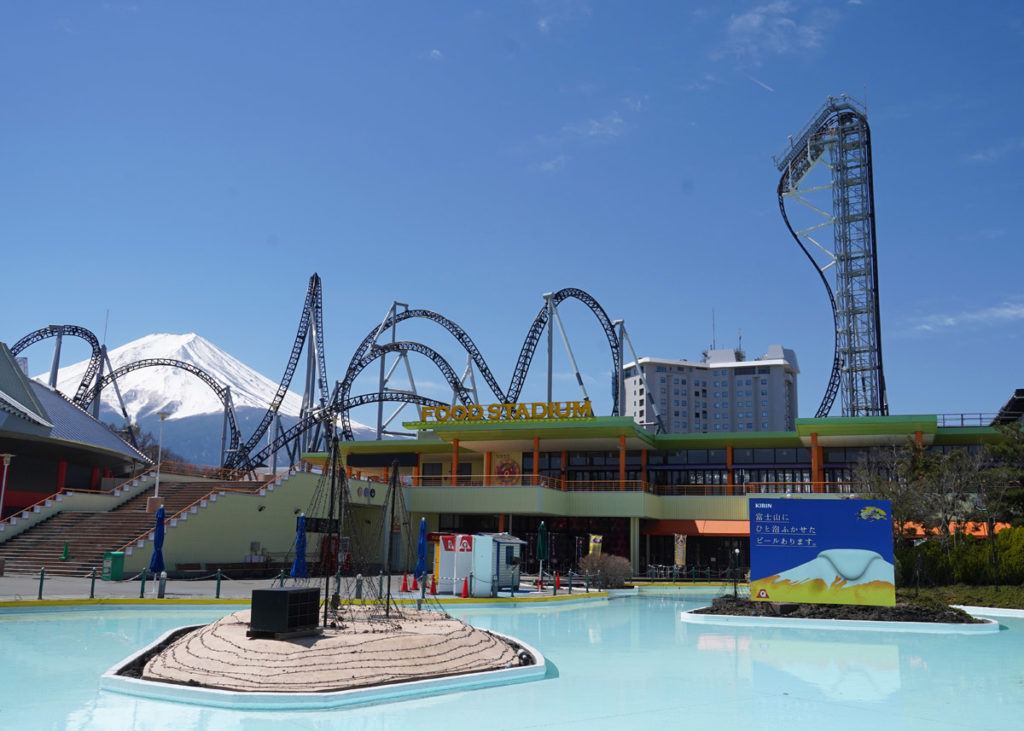
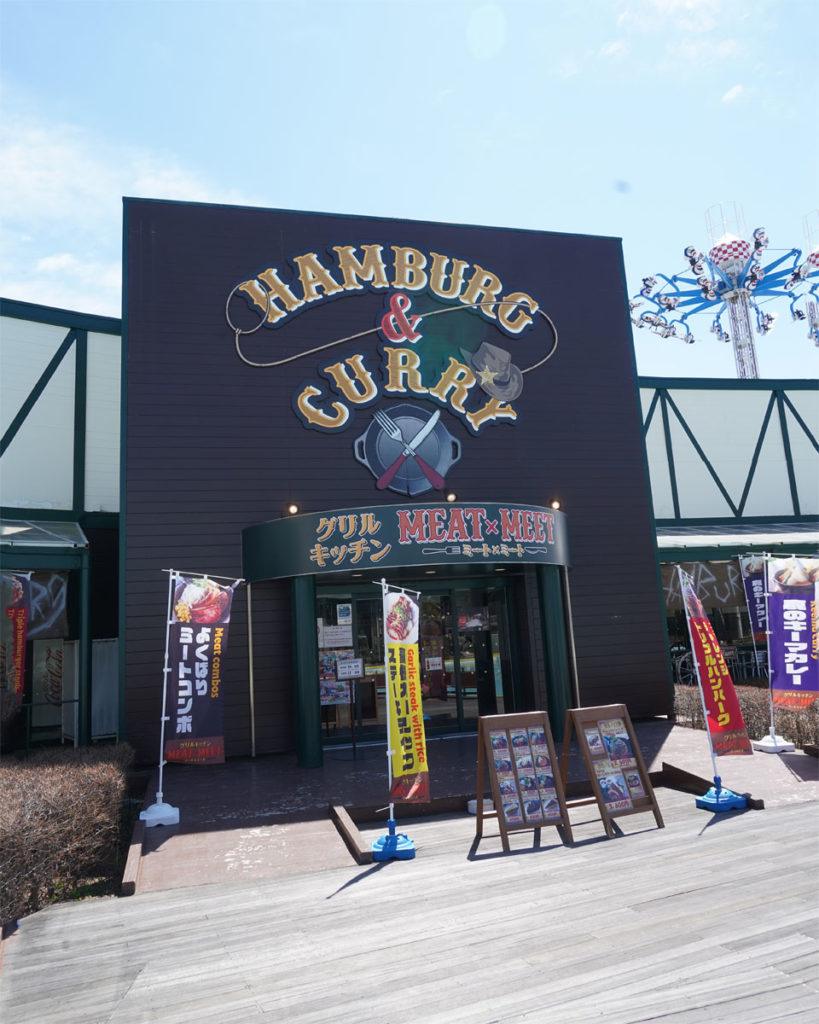
Takeaway options include places like Mosburger, Pizza La, and Ichiraku Ramen.

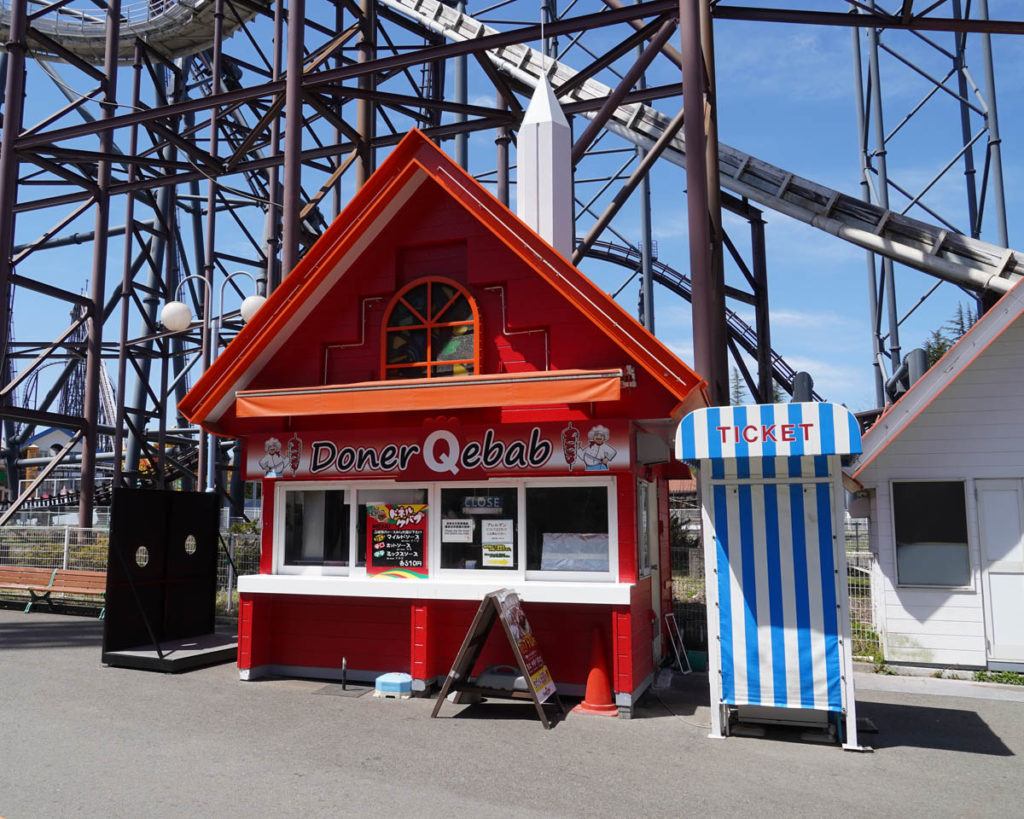
Fuji Q Opening Hours
The opening hours vary significantly from season to season so it’s best to check the monthly operating hours on Fuji Q’s website when planning your visit.
As an indication, the current opening hours until 24 September are: Weekdays 9:00 to 20:00 (9:00 am to 8:00 pm); Weekends 8:30 to 21:00 (8:30 am to 9:00 pm).
From 24 September to 27 October, the opening hours will change to: Monday to Sunday 9:00 to 18:00 (9:00 am to 6:00 pm); Saturday 9:00 to 21:00 (9:00 am to 9:00 pm)
From 28 October, the opening hours will reduce further. On most weekdays the park will close at 17:00 (5:00 pm)
Hotels Near Fuji Q
The best way to enjoy the park is to arrive a day before and book into the directly adjacent Highland Resort Hotel and Spa, which is a mid level hotel. You will get priority access to the park and be the first to get your hands on the fast pass tickets (without them you will spend the entire day in the queue).
The Fujisan Station Hotel is located a 3 minute train ride to Fuji Q and is a great budget hotel option for your Fuji Q visit.
Click here to check out price and availability of the Fujisan Station Hotel through Booking.com
If you are keen to try out a budget luxury capsule hotel experience, then check out the Mt. Fuji Cabin & Lounge Highland Station Inn which is located a 3 minute walk from Fuji Q and has separate male and female floors.
How to Get to Fuji Q Highland from Tokyo
There are two main options to travel from Tokyo to Fuji Q Highland Park. You can catch either a bus or train from Shinjuku Station in Tokyo with options as follows:
If you have an active Japan Rail Pass, you can book in to travel to Fujikyo Highland Station on the Fujikyu Line. At limited times per day the Fuji Excursion train runs direct from Shijuku Station to Kawaguchiko Station and stops at Fujikyu-Highland Station. There are also regular train options which require a change of train at various points along the route.
The more direct option is to catch either an Express Bus or Highway Bus from Shinjuku Station – the bus terminal is located above Shinjuku train station. All buses travel to Kawaguchiko Station, however all have stops at Fuji Q in both directions of travel.
Fuji Q Highland Ticket
Don’t forget to book your Fuji Q Day Dass or Afternoon Pass (which can be used from 1pm to closing) is through Get Your Guide.
Click here to check out and book your Fuji Q Day Pass or Afternoon Pass through Get Your Guide
Klook has a great Fuji Q package which includes your Fuji Q entry pass plus return direct bus trip from Shinjuku Station in Tokyo. You get 9 hours to make the most of Fuji Q and can sleep on the bus on the way back to Tokyo!
Fuji-Q Highland Amusement Park: One-Day Pass Ticket
- One-Day pass for both Fuji-Q and Thomas Land
- Select from Adult, Youth, Child, Infant and Senior ticket options
- Excludes Super Scary Labyrinth of Fear ticket
Fuji-Q Highland: Afternoon Pass Ticket
- Enjoy unlimited thrilling rides from 1:00 PM to closing
- Select from Adult, Youth, Child, Infant and Senior ticket options
- Excludes Super Scary Labyrinth of Fear ticket
Fuji Q One Day Pass with Return Bus Transfer from Tokyo
- One-Day pass for both Fuji-Q and Thomas Land
- Select from Adult, Youth and Child ticket options
- Return Direct Bus Transfers from Tokyo (Shinjuku Station) - enables you to have 9 hours to enjoy Fuji Q!
- Excludes Super Scary Labyrinth of Fear ticket
You may also like:
- Where to Purchase Studio Ghibli Museum Tickets
- Reader Mailbag: Where To Book Mario Kart In Tokyo And Japan
- Easiest Options To Get From Narita Airport To Shinjuku, Shibuya And Shinagawa
- Easiest Options To Get From Narita To Northern Tokyo, Including Ueno, Asakusa And Akihabara
- How To Sightsee Stress-Free With Klook Japan
Join the Japan Travel Planning Facebook Group

Disclaimer: This article contains affiliate links. If you book after clicking on one of these links then we may receive a small commission at no extra cost to you.
Tony Sutherland-Smith is the co-founder and key contributor to Pretraveller.com, where his extensive knowledge and passion for travel shine brightly. With a special focus on Japan and South Korea, Tony brings a wealth of practical information and insights to the table, especially regarding staying connected while abroad. His expertise in navigating the complexities of SIM cards, pocket WiFi, and eSIMs has made him an invaluable resource for travellers seeking seamless digital connectivity on their journeys.
Tony’s approach to travel writing is deeply rooted in offering reliable, detailed, and up-to-date information, making him a trusted figure in the travel community. Whether discussing Tokyo’s neon-lit streets, Seoul’s cultural richness, or the technicalities of staying connected in these fast-paced destinations, his articles reflect a combination of thorough research and personal experience.
At Pretraveller.com, Tony’s contributions go beyond just sharing travel tips; they are about enriching the travel experience of his readers. His guidance is tailored to empower travellers, helping them navigate foreign lands confidently and stay connected with the world, no matter where their adventures take them. Join Tony on Pretraveller.com as he continues to explore the nuances of travel in Japan and South Korea and offers valuable insights for the modern, connected traveller.




